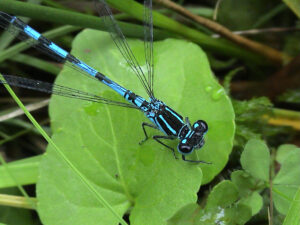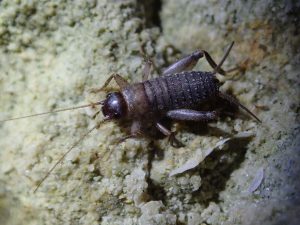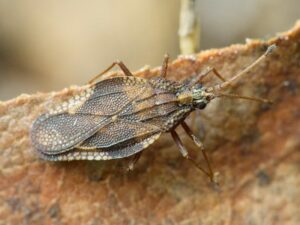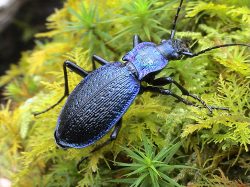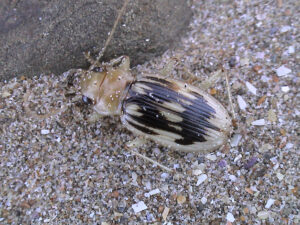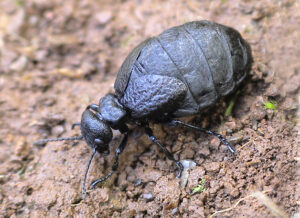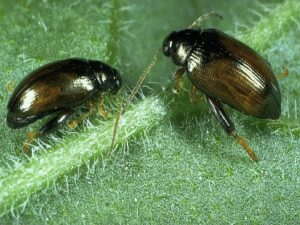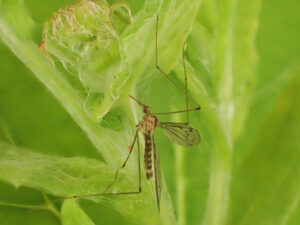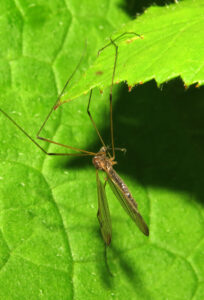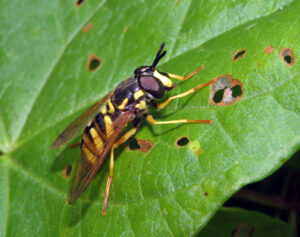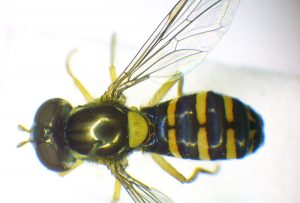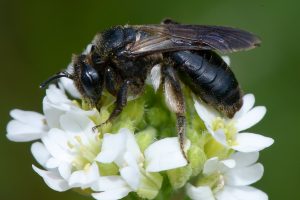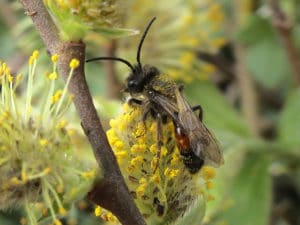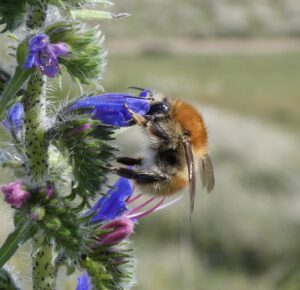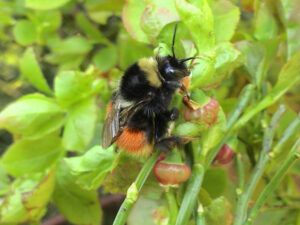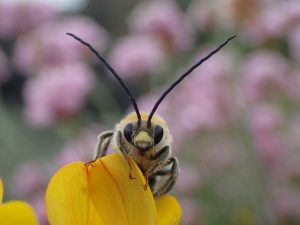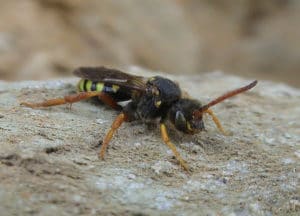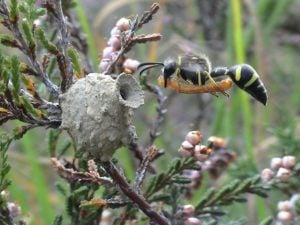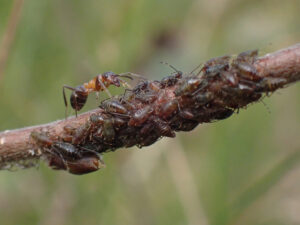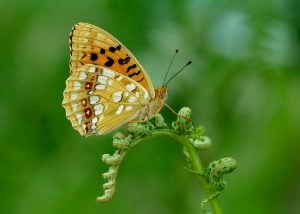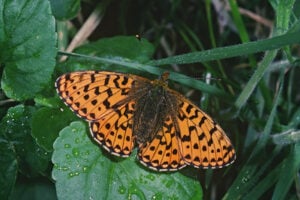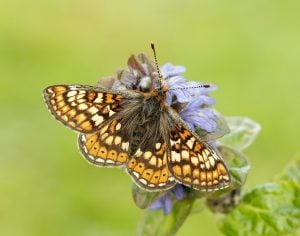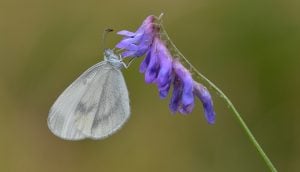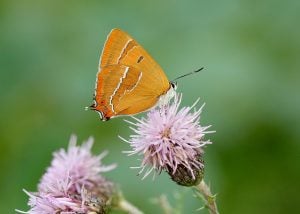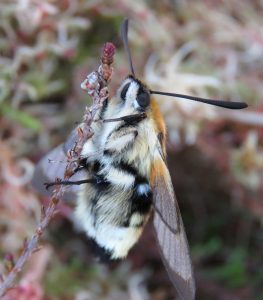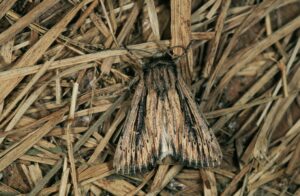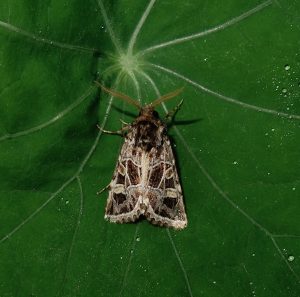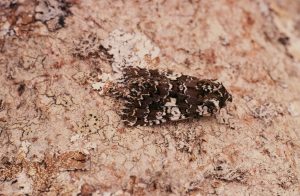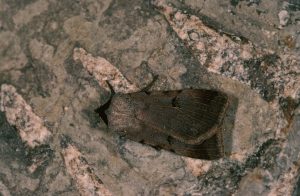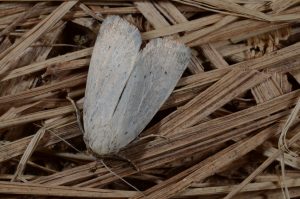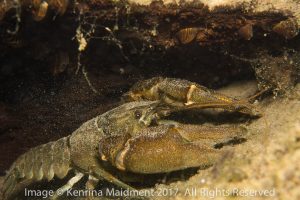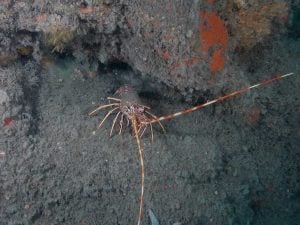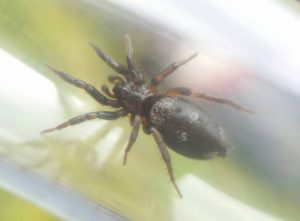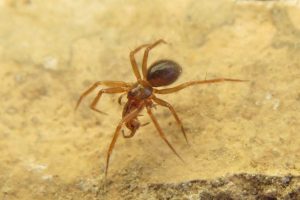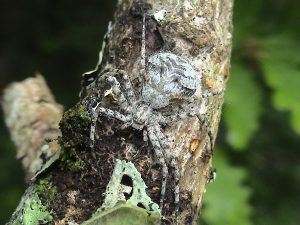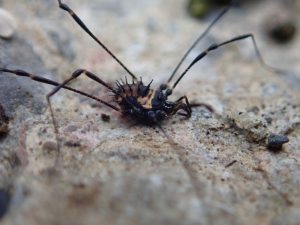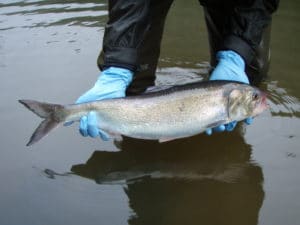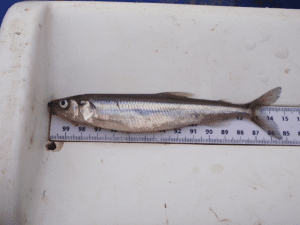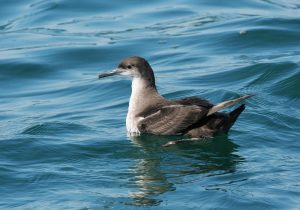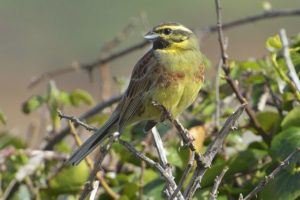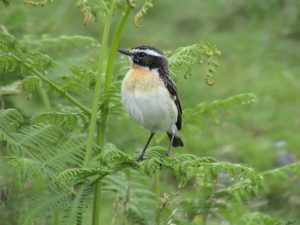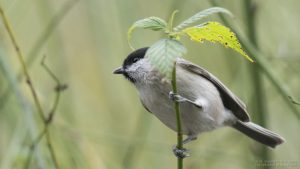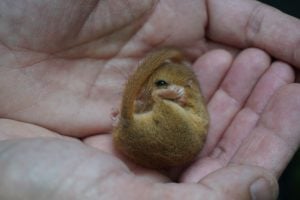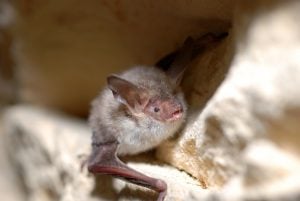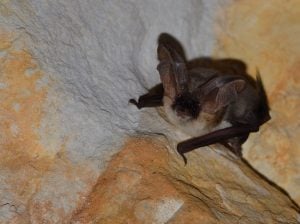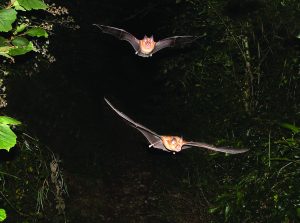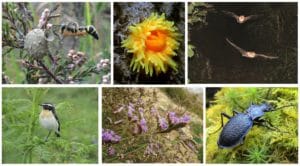In 2017 Devon County Council, DBRC and Devon species experts worked together to produce a long list of ~ 1,600 species known to be rare in Devon (Devon Priority Species) and a shortlist of 96 species (Devon’s Special Species) for which Devon has a particular responsibility.
Find out how this list was compiled.
A brief description of each of the Special Species can be found below. Many of these species remain under recorded, and systematic survey has not been carried out. If you have additional information relating to one or more of the species listed please email nature@devon.gov.uk
Please share your species stories and ideas on social media using #DevonSpecialSpecies
-
Flowering plants
Goldilocks aster (Aster linosyris) Least Concern and Nationally Rare.
Goldilocks Aster
Rob WoltonFound on coastal slopes and cliffs, Goldilocks Aster is an attractive perennial herb which favours short open turf. Berry Head is one of only six sites in Britain for this flower. The Aster is the food plant for another Devon Special Species, the micromoth Coleophora linosyridella which is only known from Berry Head and the Thames Estuary. Goldilocks Aster is under threat at Berry Head from the conflicting pressures of scrub (blackthorn) invasion in places, and intense sheep grazing in others. Although the plant remains locally frequent, in places there may have been no seedling recruitment for decades, even a century. Carefully planned management is required to ensure the long-term survival of this flower.
Map for the Devon distribution of goldilocks aster.
Lundy cabbage (Coincya wrightii). Vulnerable and Nationally Rare.
Lundy Cabbage
Natural EnglandThis plant is endemic to British Isles, existing nowhere else in the world. It is found only on the slate and granite cliffs of the south-east side of Lundy island. The cabbage is the only food plant for another Devon Special Species, the Lundy cabbage flea beetle Psylliodes luridipennis, which is also endemic to the island, as well as for the Lundy cabbage weevil Ceutorhynchus insularis.
Its preferred habitat is bare ground on cliffs or where landslips have occurred. Lundy Cabbage is threatened by grazing (rabbits and possibly goats, sheep and deer), tourist pressure (e.g. from trampling and erosion), and by invasive rhododendron. In 1994 a detailed monitoring programme was established by Leeds University and English Nature, working with the National Trust and Landmark Trust: it is not clear whether this continues to this day. Recent clearance of rhododendron has resulted in an increase in numbers, with over 50,000 plants in 2018. However, the plant typically fluctuates greatly in abundance from year to year.
Map for the Devon Distribution of Lundy cabbage.
Strapwort (Corrigiola litoralis). Critically Endangered and Nationally Rare.
Strapwort
John WaltersThis low-growing annual is now only found growing naturally in the UK only around the margins of Slapton Ley National Nature Reserve in South Devon. It is threatened by the ongoing loss of seasonally inundated, open, muddy shingle due to invasion by other plants including reed and willow scrub, reflecting the loss of cattle grazing after WWII. Now it can only be found reliably at one or two locations at the northern end of the Ley.
Wild Planet Trust and Natural England initiated a species recovery programme for Strapwort in 1996. Seed was collected and a population was established at Paignton Zoo. Propagated plants have been successfully translocated to additional sites around the Ley. However, the continued existence of the plant remains perilous, not least because it would not survive the saline conditions that would result from the shingle bar which separates the freshwater Ley from the sea being breached.
Since then, Wild Planet Trust staff have been working to establish new populations of the plant at Loe Pool, a National Trust site in Cornwall. Strapwort was found here historically and since 2015, they have been providing funding and plants (grown at Paignton from seed collected at Slapton), in the hope that they will once again establish and grow. By 2020 they will have planted close to 4,000 individual plants at Loe Pool and we are already seeing signs that reintroduced plants have established on the banks of the new site.
Map for the Devon distribution of strapwort.
Field eryngo (Eryngium campestre). Critically Endangered and Nationally Rare.
Field Eryngo
John WaltersSouth Devon, with 6 sites, has most of British population of this thistle-like plant, although it is common across Channel. It’s a perennial found on coastal cliffs and slopes, and dry, open calcareous grasslands near the coast. Three of its sites, Western King and Billacombe in Plymouth and Scabbacombe near Brixham, have been designated as SSSIs for the plant. The Plymouth populations appear stable at present, but its status at other sites is currently unclear.
Map for the Devon distribution of field eryngo
Cornish (Vigur’s) eyebright (Euphrasia vigursii). Vulnerable and Nationally Rare.
This small flower is endemic to Devon and Cornwall, being found nowhere else in the world. It is an annual of lightly grazed lowland heathland containing western gorse and bristle bent grass. Populations occur on Dartmoor, in particular on the south-western fringes. Here it is thought to be hemi-parasitic on western gorse. Any decline in grazing may put the plant at risk. It has recently been re-found on Roborough Down, but at its former best site – High Down near Lydford, where there were 21,000 plants in 2002 – few plants have been found recently, probably because gorse has increased too much. It continues to be present on Fernworthy Down in small numbers but has not been seen on Vale Down, Lydford, since grazing temporarily ceased during the foot and mouth outbreak in 2001. Dartmoor National Park Authority has had an action plan for the species.
Map of the distribution of Cornish eyebright.
White rock-rose (Helianthemum apenninum). Vulnerable and Nationally Rare.
Image by Werner Witte This attractive flower is found in Britain only on dry, open, south-facing limestone grasslands in Somerset (Brean Down) and in Devon (Torbay). Berry Head, the southern-most promontory of Torbay, holds one of the larger British colonies: here it is stable. More at risk are the populations on the smaller sites that make up the northern Torbay limestones: here that on the southern unquarried slope of Wall’s Hill must be considered the strongest.
On the southern slopes of the flagpole hill at the north-eastern end of Daddyhole Plain, Plantlife and the Torbay Coast & Countryside Trust managed to encourage significant regeneration from buried seed following clearance of gorse. In total about ten separate sub-populations are currently known along the northern Torbay limestone shores, from the 1km of coastline running immediately east of Peaked Tor Cove round to just north of Daddyhole Plain and from the 400 metre stretch along the southern and, more rarely, eastern sides of Wall’s Hill. The flower is vulnerable to overgrowth of scrub and to any decline in rabbit grazing.
Map of the Devon Distribution of white rock-rose.
Toadflaxed-leaved St John’s-wort (Hypericum linariifolium). Near Threatened and Nationally Rare.
Image by Rodger Smith This perennial plant now survives only in East Cornwall, South Devon and Caernarvonshire. In Devon its strongholds are on the edge of Dartmoor, in the Teign and Dart valleys, and on cliffs near Dartmouth. It occurs mainly on rocky outcrops in wooded valleys where it is threatened by the loss of bare ground and by scrub overgrowth. The plant seems still to be present in most of its known locations. Active management is necessary at many sites to maintain favourable conditions for the flower: the last review of site conditions and population strength was carried out in the mid-1990s. Further survey work is required now to establish the true extent of populations.
Map of the Devon Distribution of toadflaxed-leaved St John’s-wort
Wavy St John’s-wort (Hypericum undulatum). Least Concern and Nationally Scarce.
Wavy St John’s Wort
John WaltersThe main UK stronghold for this attractive flower is on the Culm Measures in north-west Devon, but it also occurs in Cornwall and in south-west Wales. A perennial herb, it grows in wet acidic grasslands and fen meadows. Sites have been lost in the past through agricultural intensification or through scrub invasion reflecting a lack of grazing. The population in Devon is currently likely to be stable or increasing – it is a species that will have benefited from several decades of work to save and conserve Culm Grasslands spearheaded by the Devon Wildlife Trust.
Map of the Devon distribution of wavy St John’s-wort.
Rock sea-lavender species (Limonium binervosum agg.) Nationally Rare.
An aggregate of three species, L. binervosum, L. procerum and L. britannicum, all of which are nationally very rare and endemic to the British Isles: some subspecies are endemic to the Devon coast. They are coastal plants of rocks and head deposits, but are occasionally also found on shingle, pebble beaches and upper saltmarsh. The subspecies, which are found only in Devon, occur on coastal rocks and head deposits along the south coast. Devon populations are probably stable, although very small on some sites. Image by John Walters.
Map of the Devon distribution of rock sea-lavender.
Heath lobelia (Lobelia urens). Vulnerable and Nationally Rare.
Image by John Walters A perennial herb of wet, acidic, grassland, this flower is now known from only six sites in British Isles, all in southern England. The population in Andrew’s Wood in south Devon, a Devon Wildlife Trust reserve, is the largest. Here numbers fluctuate greatly from year to year. When numbers start to dip, the Trust does more mechanical vegetation clearance to create the bare ground that the plant requires for seed germination. The warming climate may favour competitor species like rushes and purple moorgrass and be detrimental to the lobelia. There is a small remnant population near Shute in East Devon – the current status of this is currently unclear.
Map of the Devon distribution of heath lobelia.
Sea stock (Matthiola sinuata). Vulnerable and Nationally Rare.
Image by Nicola Prisco Formerly known from several coastal areas in western Britain, from the Isles of Scilly to Anglesey, there are recent Great Britain records for this attractive plant of sand dune systems only from northern Devon (Braunton Burrows, Northam Burrows and Instow) and from Glamorgan. At Braunton Burrows the plant has increased as a result of dune vegetation clearance, and will doubtless benefit from further, much larger scale work under the Dynamic Dunescapes project, planned to start in autumn 2020, led by Plantlife working together with the Christie Estate. This will see the vegetation removed from about 22 hectares of wet slack and associated dry dunes, and from a further 10 hectares of dry foredune, all to encourage natural mobilisation of the duneland landscape, for the benefit plants like Sea Stock. Image by Nicola Prisco.
Map of the Devon distribution of sea stock.
Bastard balm (Melittis melissophyllum). Vulnerable and Nationally Scarce.
Image by John Walters In the British Isles this perennial plant of woodland edge, open woodland, hedge bank, roadside and sheltered sea cliff is largely restricted to Devon and East Cornwall: elsewhere it is declining. The plant responds well to regular cutting of ground vegetation and to the coppicing of overhanging trees, to remove dense shade. Overall, it is probably holding its own in the core area of South Devon and the fringes of Dartmoor, but populations are often small and sporadic. In north Devon it is associated mainly with coastal woods and the Taw and Torridge valleys
A survey was carried out in 2010. Over the last 30 years it has been seen in 72% of the tetrads where it has ever been recorded in Devon, and in some new ones. Along with shade cast by overhead trees, eutrophication (artificial nutrient enrichment) along Devon lanes is a threat, leading to increased competition from other plants.
Map of the Devon distribution of bastard balm.
Plymouth pear (Pyrus cordata). Vulnerable and Nationally Rare.
Plymouth Pear
John WaltersThis tree is known naturally from only two places in the British Isles – Plymouth and near Truro, with a total of just 600-700 individuals. The two native Plymouth sites, together notified as an SSSI, occur on or immediately around the former Buckland Common, an expansive area that formerly linked to Roborough Down but was subsequently lost to airport and other development. Both sites are hedge remnants and the trees are growing in amongst other species.
Natural England intends to assess site condition in 2020, and a workshop for stakeholders is planned this year too, to review the condition of the trees and sites, and to decide whether further conservation action is necessary. Although given special protection under law, the tree is at risk from unauthorised felling, as happened in 2012 when a large specimen was unlawfully felled. The tree has been propagated, and specimens introduced to a few sites within Plymouth and in Cornwall.
Map of the Devon distribution of Plymouth pear.
Sand crocus (Romulea columnae). Vulnerable and Nationally Rare.
In the British Isles, this tiny crocus is only known from Dawlish Warren in Devon and from a site in Cornwall: it is also found in the Channel Islands. The Dawlish Warren colony is far larger than the Cornish one. At Dawlish Warren, a National Nature Reserve, the plant occurs in dry short sandy turf. The area occupied by the crocus has recently expanded on land managed by Teignbridge District Council and the plant is also doing well on the adjacent golf course which forms part of a Devon Wildlife Trust reserve. Sea level rise, leading to habitat loss through erosion, is a threat.
Map of the Devon distribution of sand crocus.
Triangular club-rush (Schoenoplectus triqueter). Critically Endangered and Nationally Rare.
Image by Brett Westwood The only known British site for this club-rush is on the muddy banks of a tidal stretch of the river Tamar. The plant was last seen on the Cornish side in 1958 and finally disappeared from the Devon side by 2010. However, in 1997/8 and again in 2010 it was re-introduced into sites on both banks, with seed taken from Tamar populations. By 2013 plants were still present at all sites – no more recent information is available. The club-rush is thought to have been lost because it was out-competed by expanding reedbeds, perhaps resulting from raised nutrient levels in the river.
Map of the Devon distribution of triangular club-rush.
Round-headed club-rush (Scirpoides holoschoenus). Endangered and Nationally Rare.
Image by Mary Breeds In the British Isles, native populations of this club-rush occur only at Braunton Burrows in North Devon and at Berrow Dunes in North Somerset. Braunton Burrows, a major sand dune system, is the national stronghold. Here the population is considered stable and has benefited from recent scrub and other vegetation removal. It will doubtless benefit from further, much larger scale, work under the Dynamic Dunescapes project, planned to start in autumn 2020, led by Plantlife working together with the Christie Estate. This will see 22 hectares of wet slack and associated dry dunes devegetated, and about 10 hectares of dry foredune devegetated and notched (to encourage natural mobilisation of the duneland landscape). The plant does, however, remain under some threat from heavy grazing by cattle and this will need careful monitoring.
Map of the Devon distribution of round-headed club-rush.
Devon whitebeam (Sorbus devoniensis) and allied species. Nationally Scarce, most of the allied species are Nationally Rare.
Image by John Walters Devon Whitebeam is endemic to the British Isles, being found nowhere else in the world. The tree is largely restricted to Devon (especially north Devon) and to a small area of south-east Ireland. In Devon most trees occur in hedges, although some grow open woodland. The species is representative of a suite of other rare or scarce whitebeams restricted wholly or mainly to the British Isles, including English Whitebeam Sorbus anglica, Grey-leaved Whitebeam Sorbus porrigentiformis, Rock Whitebeam Sorbus rupicola, Bloody Whitebeam Sorbus vexans, Slender Whitebeam Sorbus subcuneata, Watersmeet Whitebeam Sorbus admonitor and Margeret’s Whitebeam Sorbus margaretae. The county population of Devon Whitebeam appears stable, with new sites being found every year. Natural regeneration was noted under two trees on Roborough Common in 2018. Populations of allied species are probably stable too, although some of these are very small.
Map of the Devon distribution of Devon whitebeam.
Water germander (Teucrium scordium). Endangered and Nationally Rare.
Image by Mary Breeds This very rare perennial is now known only from two places in Britain: a site in Cambridgeshire and Braunton Burrows in Devon. It is also found in western Ireland. Braunton Burrows has by far the largest population in Britain. Here numbers have declined from 36,000 about 20 years ago to a few thousand in 2019, but there has been a small resurgence in numbers following vegetation clearance and fencing off a small pool to prevent excessive cattle trampling, carried out by Plantlife and the Christie Estate.
The plant used to occur at Northam Burrows on the other side of the mouth of the Taw-Torridge estuary from Braunton Burrows. Here the population numbered about 10,000 shoots in c. 2000, confined to just a single slack: by 2011 this had reduced massively to just nine shoots, and no plants were seen in the following three seasons. Following very tight strimming four small shoots appeared in 2014 but is thought the plant is now extinct at Northam Burrows. Water Germander is at particular risk from dry summers, when a falling water table results in the slacks (wet dune hollows) where the plant occurs becoming dry for lengthy periods: it is at risk from climate change.
The Dynamic Dunescapes project, planned to start in autumn 2020, led by Plantlife working together with the Christie Estate, will include scraping or lowering eight to ten slacks at Braunton Burrows where Water Germander occurs, to create favourable conditions for the plant and to reduce the likelihood of the slacks drying out.
Map of the Devon distribution of water germander.
Further Sources of Information:
-
Mosses
Rabbit-moss (Cheilothela chloropus). Near Threatened and Nationally Rare.
Rabbit-moss (Cheilothela chloropus), The Species Recovery Trust. Rabbit-moss (Cheilothela chloropus), The Species Recovery Trust. This moss is only known in Great Britain from colonies at Torbay and Dawlish Warren National Nature Reserve in Devon, and from a handful of sites on the Mendips in Somerset. It grows in short rabbit-grazed turf on limestone, often on rocky ground which becomes intermittently desiccated in summer. It is surviving well at its Torbay sites (Walls Hill, Hope’s Nose, Daddyhole Plain, Petitor and Berry Head) and there is a small population in a large slack at Dawlish Warren; all these sites were checked in 2018. It is at risk from changes in site management and in grazing intensity, especially from a fall in rabbit numbers.
Multi-fruited Cryphaea moss (Dendrocryphaea lamyana). Vulnerable and Nationally Rare.
Good populations of this moss grow in a few places beside rivers in Devon, otherwise the only British records are from south-west Wales. It grows only on rocks and trees by the side of large rivers. In Devon it is known from the rivers Bovey (near Pullabrook Bridge), Dart (near Austin’s Bridge), Tamar (including the Cornish side), Torridge (near Beaford Bridge) and Taw (near Umberleigh); and has recently (2019) been found beside the River Mole (near Arshaton Wood). In general, populations in Devon are doing well, but vigilance is required to ensure the localities where it occurs are managed appropriately and not being damaged by changes in river flow, tree management, etc.
Map of the Devon distribution of multi-fruited cryphae moss.
Further sources of information:
-
Lichens
Horsehair lichen (Bryoria smithii). Critically Endangered and Nationally Rare.
Image by April Windle This hair-like lichen is now probably extinct in Scotland and Wales and is known to survive in the UK only at two sites in Devon, both on Dartmoor: Blacktor Copse, where it was last recorded in 2016, and at Wistmans Wood where it was re-found in 2017. It grows as an epiphyte on upland oak trees. It is likely to be at risk on Dartmoor from changes in climate, from air pollution, and from new oak pests and diseases.
Map of the Devon distribution of Horsehair lichen.
Tree catapyrenium lichen (Catapyrenium psoromoides). Critically Endangered and Nationally Rare.
Image by April Windle This lichen is known only from one site in Scotland and four in southern England. Devon is a stronghold, with Chudleigh Rocks a major site. Here it grows on moss on rocks, and it is at risk from competition from flowering plants. Devon lichenologists intend to visit Chudleigh Rocks in 2020 to assess the lichen’s status there.
Scrambled-egg lichen (Gyalolechia fulgens) Endangered and Nationally Rare.
Image by Mary Breeds This orange-yellow encrusting lichen is known from just six sites in England and two in SW Wales. Braunton Burrows in Devon is an important site for it. Here it is at risk from the open compact ground it lives on being taken over by flowering plants and invaded by scrub. Its major population on Pebble Slack appears to be stable, but the species has been lost from a couple of places further north in the Burrows through smothering by taller vegetation including sea buckthorn. The Dynamic Dunescapes project, planned to start in autumn 2020, led by Plantlife working together with the Christie Estate, will see extensive areas of scrub removed, and open ground create, and should benefit the lichen.
A scribble lichen (Opegrapha subelevata). Endangered and Nationally Rare.
This lichen is only found on Devon and Dorset coasts, on shale rocks. In Devon it has been found on both coasts. Berrynarbour on the north coast is a major site. Here it is threatened by a sheet of ivy falling down from high on the cliff above. Control of this ivy is likely to require specialist climbers. Devon lichenologists are keeping an eye on the species and will advise on management requirements. Berrynarbour is also the location for another lichen that is a Devon Special Species, the Fringed Shield Lichen Parmelina carporhizans.
A foliose lichen (Parmelia submontana). Data Deficient and Nationally Rare.
Foliose lichen
Barbara BenfieldDespite being a large species usually occurring in some abundance at the sites where it occurs, it is currently known in the UK from only two sites of Dartmoor, where it has been only recently discovered, and one in Wales. On Dartmoor it is found on ten willows in the Devon Wildlife Trust’s Emsworthy Mire reserve, and on willows at the Heatree Activity Centre near Manaton. A species that is not easily overlooked, its range may be expanding. It is threatened by clearing willow carr, a habitat that is currently much undervalued in Devon, by air pollution and perhaps from climate change leading to summer droughts.
Map of the Devon distribution of a foliose lichen.
Fringed shield lichen (Parmelina carporhizans). Vulnerable and Nationally Scarce.
Devon is a national stronghold for this lichen. It grows on well-lit branches, mainly near the coast, and is found along both Devon coasts and at a few inland sites. Coastal locations include the East Devon Undercliffs and Berrynarbour on the north coast – the latter place is also the location for another Devon Special Species lichen, Opegrapha subelevata. The lichen also used to occur on a lime tree at Arlington which was felled. Seldom occurring in quantity, this lichen may be at risk from brambles and other undergrowth smothering the trees on which it grows.
String-of-sausages lichen (Usnea articulata). Near Threatened and declining.
String-of-sausages lichen
Barbara BenfieldFormerly widespread, this striking beard lichen is now largely confined to South-West England, Devon being its UK stronghold. It is typically found hanging from the branches of trees, often high up, both in and outside woodlands. Another beard lichen, Usnea florida, which is also threatened and declining, occurs in similar places: Devon is a national stronghold for it too. Both species are highly sensitive to air pollution. Although apparently holding their own in Devon, they are locally placed at risk by high ammonia emissions from intensive livestock units.
A Map of the Devon distribution of string-of-sausages lichen.
Wadeana dendrographa, a lichen. Near Threatened and globally rare.
Devon, along with Dorset and Cornwall, is a national stronghold for this lichen. It grows on the bark of ancient or veteran trees, favouring ash. Known sites in Devon have not been visited recently, except for an ash on National Trust land near the donkey sanctuary at Branscombe. The lichen is at high risk from ash dieback disease, caused by the pathogen Hymenoscyphus fraxinea, a fungus.
Map of the lichen Wadeana dendrographa.
Further sources of information:
-
Fungi
Fragile amanita toadstool (Amanita friabilis). Endangered and Nationally Rare.
This toadstool is a European endemic species associated with alder carr where it is a mycorrhizal associate exclusively of alder trees. It is known from just five hectads in England and Wales. In 1999 it was recorded at Hembury Woods in Devon, the only place it is currently known from in the county. However, it could occur anywhere alders are growing. As with most fungi, the precise habitat conditions it requires are unknown, so the focus must be on the conservation of wet woodlands, a habitat currently often either ignored or under-valued in Devon. Clearance, drainage and mismanagement are among the threats to the habitat.
Fuscoporia wahlbergii a bracket fungus. Endangered? and Nationally Rare.
An extremely rare polypore bracket fungus found on the dead parts of ancient and veteran oak trees in historic mediaeval forests and deer parks. Old open-grown oaks seem to be the key habitat: the known European range is France, Ireland and England where it has been reported from just three sites: Woodend Park near Shute (East Devon), Langley Park (Bucks) and Staverton Park (Suffolk). At Woodend Park it occurs on the King John Oak, where in 2008 the species was found for the first time in Britain. The Oak Polypore Fungus Piptoporus quercinus, another Devon Special Species, also lives on ancient oaks in Woodend Park. In recent years bramble and scrub have been cleared away from around the base of the King John Oak, enabling the fungus to be better monitored and hopefully benefiting it.
The precise ecological requirements of the fungus are not known, and even if they were it is improbable that we would be able to precisely create them. However, we can be sure that it is under threat from through the continuing losses of old oaks in parkland situations, through excessive tidiness resulting in the removal of dead and decaying wood, coupled with misconceptions about health and safety; also in the long-term from a failure to establish new generations of open grown trees. Parkland and wood pasture trees are subject to a wide range of additional threats, from damaging activities such as overstocking with livestock, the widespread use of chemical fertilisers and compaction.
Oak polypore fungus (Piptoporus quercinus). Endangered and Nationally Scarce.
Image by Niklas Jansson This is a bracket fungus of ancient oaks; the fruiting bodies usually being found during the summer months. Woodend Park, Shute (East Devon), is a major location for it, and indeed a flagship site for ancient oak fungi – another the Devon Special Species bracket fungus, Phellinus wahlbergii, also occurs here. Please see that species for an account of its conservation requirements and threats to the habitat. There are unconfirmed reports of the Oak Polypore occurring elsewhere in Devon.
Hazel gloves fungus (Hypocreopsis rhododendri). Near Threatened and Nationally Scarce.
Hazel gloves
Rob WoltonThis is an aptly named fungus of moist woodland and scrub where it occurs on hazel, being parasitic on another fungus, a glue crust, Hymenochaete corrugata. North-west Devon is an important British stronghold – here it occurs quite frequently, typically on the stems and branches of mature hazel bushes growing near rivers and streams. In recent years many new localities for it have been found in north-west Devon and it is likely to be increasing in frequency. In southern Devon it is only known from one location, where it occurs on blackthorn. It is threatened by coppicing, scrub removal, removal of woodland undergrowth and clearance of bankside trees and bushes.
Map of the Devon distribution of hazel gloves fungus.
Further sources of information:
-
Corals and Sea Fans
Pink sea fan (Eunicella verrucosa). Internationally Vulnerable and Nationally Scarce.
Pink sea fan
Keith HiscockAn attractive species, Devon, especially off Plymouth, is a national stronghold for this predominantly south-western sea fan, a type of coral. It grows on large boulders, upward facing bedrock and shipwreck plates at depths usually greater than 15 m. The sea fan supports several other species that settle either only or mainly on it, including rare and scarce ones. Populations are currently thriving off south Devon, but those along the North Devon mainland coast remain low and are probably not increasing.
Populations within the Marine Nature Reserve off Lundy island remain lower than in the 1960s to mid-80s. Here the species was badly affected by collection in the 1960s and by disease in the early 2000s. Recovery around the island seems very slow but up-to-date information is needed. This slow-growing, long-lived, fragile species is very vulnerable to physical damage by divers but is particularly threatened by mobile fishing gear, as used by scallop dredgers.
Sunset cup coral (Leptopsammia pruvoti). Nationally Rare.
Mike Deaton- sunset cup coral In Great Britain this attractive soft coral is known only from seven places: these include the seas around Lundy and off Plymouth. It prefers to live on shaded bedrock or stable boulders and is usually found in overhangs or gullies 10-40 m deep. Currently it is thriving on the Plymouth Sound Dropoff (2nm south of the breakwater). However, numbers continue to be greatly reduced at Lundy (to about 30% of population levels in the 1980s), although up-to-date information is needed. The reasons for the species’ decline at Lundy are unknown, but it seems likely that it is vulnerable to subtle environmental changes affecting either recruitment or the growth of other marine life competing for space on the rocky surfaces it lives on. Further research is required.
-
Sponges
Adreus fascicularis, a sponge. Nationally Scarce.
Adreus fascicularis
Keith HiscockRestricted in Britain to the south-western, this scarce sponge is fairly widespread in appropriate habitats off south Devon and is present around Lundy island. It has been recorded at several new locations by Seasearch surveys in recent years. The sponge lives on rock that is covered in a layer of sand – a very patchy habitat, restricted in extent. It is at risk from mobile fishing gear, as used by scallop dredgers.
Yellow staghorn sponge (Axinella dissimilis).
Yellow staghorn sponge
Keith HiscockThis long-lived and charismatic sponge occurs widely on western coasts throughout the British Isles. Particular concentrations are to be found in appropriate habitats off south Devon and off Lundy island. The species lives on rocky parts of the seabed. Research has shown it to be extremely slow growing and individuals can be very old, perhaps several hundred years old. Populations seem currently to be stable. However, the sponges are susceptible to mobile fishing gear (although this is not a method generally used on the rough seabed where they live) and they can also become entangled in set and lost nets. There is concern that the use of tangle nets laid over rocky seabed to catch European Spiny Lobsters (another Devon Special Species and one whose populations have recently much recovered) may result in an increased in sponge loss and harm populations.
Further sources of information:
-
Molluscs
Freshwater pearl mussel (Margaritifera margaritifera). Critically Endangered and declining.
Although this mussel’s stronghold is in Scotland, the conservation of the species across its range is important. It survives in only ten rivers in England. The River Torridge in Devon supports the only sizeable population in southern England. Here about 2,000 individuals live between Hatherleigh and Great Torrington, the last full survey being in 2013 – it is hoped to repeat this in 2020. There is also a very small population (below 100 individuals) on the River Mole. The Devon populations are thought to have the same genetic provenance as those on the Iberian peninsula, unlike those found elsewhere in northern England and Scotland.
Freshwater pearl mussels occupy clean, fast flowing streams and rivers. As larvae, they live in the oxygen-rich environment of salmon or trout gills. Individuals can live for over 120 years! However, in Devon in recent years no individuals under 50 years old have been found and they are not thought to have bred successfully since the 1960s. The Freshwater Pearl Mussel Project, led by the Devon Wildlife Trust, has been working with local landowners and others to improve water and habitat quality on the Torridge. The project has also successfully instigated a captive breeding programme with some success; juveniles have been put back into the Torridge, but they won’t be detectable for five years at least. The species is threatened by siltation or other damage to river gravels, by water pollution, and by illegal pearl fishing.
Map of Devon distribution of freshwater pear mussel.
Sand amber snail (Quickella arenaria). Vulnerable and internationally threatened.
Image by Mary Breeds This small snail is known from only three locations in Great Britain: in Devon in slacks (hollows) between the sand dunes on Braunton Burrows and in Cumbria in base-rich flushes on Orton Gill and Crosby Gill. At Braunton Burrows it remains frequent but is at risk through vegetation succession reflecting a lack of grazing and from dune slacks drying out due to lowering of the water table or climate change. The Dynamic Dunescapes project, planned to start in autumn 2020, led by Plantlife working together with the Christie Estate, will include the scraping or lowering of eight to ten slacks at Braunton Burrows to create favourable conditions for plants like Water Germander (another Devon Special Species). This conservation work is likely to benefit the snail.
Further sources of information:
-
Dragonflies
Southern damselfly (Coenagrion mercuriale). Endangered and Nationally Rare.
Southern Damselfly
John WaltersThis dainty damselfly is declining throughout its European range. Although its two main British strongholds are in the New Forest and the Preseli mountains, Pembrokeshire, the colonies in East Devon and on Dartmoor are considered of international significance. This species has specialised habitat requirements, being confined in Devon to shallow, well-vegetated, base-rich runnels and flushes. There are seven extant colonies in the county, including one satellite (Lower Prewley), of which four are on Dartmoor and three are on the East Devon Pebblebed Heaths (EDPH). Transects at all sites are monitored annually for adults, while the Dartmoor sites are checked for larvae in spring. Three sites have experienced substantial increases in numbers following the introduction of positive management during the last 25 years.
The trends for six sites are currently judged to be stable, apart from one EDPH site (Colaton Raleigh Common), where numbers have crashed to single figures for the last four years; the reasons for this are unclear but may be related to the cessation of water loss from a leaking pipe. Two sites in the Blackdown Hills, Southey Moor and Hense Moor, were last occupied in 1959 and 1965, respectively; a recent translocation attempt at the latter appears to have failed. However, extinction in 1991 at one EDPH site, Venn Ottery Common Devon Wildlife Trust Reserve, was followed by targeted management and successful re-establishment using New Forest stock in 2007 and 2009.
Map of the distribution of southern damselfly.
Further Sources of information:
-
Grasshoppers and Crickets
Scaly cricket (Pseudomogoplistes vicentae). Vulnerable and Nationally Rare.
Scaly bush cricket John Walters This cricket is known in the UK from only four small and apparently isolated populations: Branscombe (East Beach) in Devon, Marloes sands and Dale beaches in Pembrokeshire and Chesil Beach in Dorset. It inhabits shingle beaches, living under rocks and beach debris, and is often associated with the seaweed strandline. The females appear to prefer to lay their eggs in driftwood. The population at Branscombe appears strong, with 25+ being easily found by torchlight on 22 October 2019. Populations are threatened by both the increase in the frequency of severe weather events and rising sea levels associated with climate change, and by marine pollution events. A further potential threat is the collection of driftwood and the construction of driftwood bonfires.
Further sources of information:
Grasshoppers and Related Insects Recording Scheme of Britain and Ireland
-
True bugs
Apple lace bug (Physatocheila smreczynskii). Nationally Rare.
Apple Lace Bug
Boris LobodaModern records of this lace bug are known only from Cornwall, Devon and New Forest. It is found chiefly on lichen-covered apple trees, both crab apple in woodland and cultivated apple in traditional orchards. The National Trust’s Ashclyst Orchard is the only place where this bug has been seen on more than one occasion, most recently on 17th August 2016. The NT’s Killerton Estate has been restoring this traditional orchard, formerly engulfed by bramble, by opening it up and establishing a new generation of trees and have expanded its size by incorporating some neighbouring apple trees into the same enclosure. No information is available, however, on the status of the species or its habitat at other known sites in the county. Any further loss of traditional orchards may put this species at risk.
Map of the Devon distribution of apple lace bug.
Further sources of information:
-
Beetles
Actocharis readingii, a rove beetle. Red listed and Nationally Rare.
This small staphylinid beetle lives under stones between the tide lines on sandy shores. It has recently been discovered in south-west Wales but is otherwise known only from the Channel Islands (1 hectad), Cornwall (2 hectads) and Devon (8 hectads). Devon is, as far as is known, the British Isles stronghold. However, it is probably under-recorded reflecting its obscure habitat. Last recorded in 2017, the status of the beetle in Devon is uncertain, and further survey and monitoring are required.
Gabrius astutoides, a rove beetle. Red listed and Nationally Rare.
This rove beetle of river and stream shingles is known mainly from Devon (eight hectads, five since 1980), with fewer records in Cornwall and one in south Wales. The most recent record is from Gara Mill in 2014. The beetle is likely to be at risk from riverine shingle extraction, watercourse engineering works and any decline in water quality.
Map of the Devon distribution of a rove beetle.
Blue ground beetle (Carabus intricatus). Near Threatened and Nationally Rare.
Image by John Walters This large dark blue beetle is restricted to some ten sites, all either on Dartmoor in Devon or on Bodmin Moor in Cornwall, except for one recently discovered in south Wales. It inhabits deciduous woodlands with high humidity and much moss. The adult beetles feed on slugs and hibernate under moss-laden dead bark. Ad hoc monitoring is carried out by Buglife, John Walters and others: the Dartmoor populations appear stable. It would be placed at risk by changes in management of the moorland edge woodlands where it occurs if the ecological requirements of the beetle were not taken into account. It may become the subject of Ph.D. research from Exeter University.
Beach comber beetle (Eurynebria complanata). Endangered and Nationally Rare.
Beachcomber beetle
John WaltersThis beetle occurs on the strandlines of beaches backed by sand dunes. Here it shelters, forages and lays its eggs under woody and especially large pieces of plastic debris. It occurs, or occurred, on Saunton Sands (Braunton Burrows) but was last recorded there in 2002 and may now be extinct in Devon and as a result in England. However, its ecology is poorly understood and the beetle may reappear – further searching is required. The remaining British stronghold is in South Wales, although it is apparently declining here and is now limited to seven localities. Once the reasons for its loss have been examined, the beetle could be a good candidate for reintroduction to Saunton Sands from South Wales. Beach cleaning and the removal or burning of driftwood are likely to have major implications for the species.
Map of the Devon distribution of a beach comber beetle.
Gravel water beetle (Hydrochus nitidicollis). Vulnerable and Nationally Rare.
The water beetle is known only from Cornwall and South Devon. It is typically found in pockets of still water among coarse gravel in shingle beds at the edges of rivers and open water. It has been found during surveys of the River Bovey and River Teign, including within several sites in Dartmoor National Park. However, it has been recorded from just two hectads in Devon since 1980 and some sites have apparently been lost. Regulation of river systems, such as deepening or straightening, will be detrimental. However, overall, the narrow distribution of the beetle in England indicates a strong dependency on a warm Atlantic climate rather than on a particular management practice or habitat.
Map of the Devon distribution of gravel water beetle.
Mediterranean oil beetle (Meloe mediterraneus). Vulnerable and Nationally Rare.
Mediterranean Oil beetle
John WaltersThought extinct in the UK, this species was rediscovered in Britain in 2012, in Devon, after a gap of nearly 100 years. It is now known from five coastal sites in south Devon and East Sussex. This beetle is a cuckoo parasite in the nests of solitary bees. Its larvae emerge in June and wait on flowers to hitch a lift back to a suitable host bee nest. Once inside they feed on the pollen supply collected by the bee for her own larvae. The adults emerge in late September and are active throughout the winter, but only at night.
John Walters monitors the beetle on an ad hoc basis, and records continue to be received by Buglife through the Oil Beetle Hunt. In 2019 John found good numbers at Prawle Point (e.g. 29 in one hour). The key Devon population on National Trust land at Bolberry needs monitoring, in part to check that path resurfacing work has not damaged the population there. Light to moderate rough grazing is thought necessary to maintain the sward in suitable condition for the oil beetle: heavy grazing has the potential to be damaging by removing the flowers on which the host bees are dependent.
Map of the Devon distribution of Mediterranean oil beetle.
Lundy cabbage flea beetle (Psylliodes luridipennis). Critically Endangered, endemic.
Lundy cabbage flea beetle
Roger KeyThe world distribution of this beetle is limited to Lundy island. Here it is found along the south east coast. It inhabits sea cliffs, granite outcrops and cliff grassland. Both larvae and adults feed solely on Lundy Cabbage, also a Devon Special Species and endemic to the island. Lundy Cabbage is threatened by grazing (rabbits and possibly goats, sheep and deer), tourist pressure (e.g. trampling and erosion), and invasive rhododendron. Recent clearance of rhododendron has resulted in an increase in the number of Lundy Cabbage plants, with over 50,000 in 2018. It is not known whether this has resulted in an increase in numbers of the flea beetle.
Map of the Devon distribution of Lundy cabbage flea beetle.
Further sources of information:
-
True Flies
Dicranomyia goritiensis, a cranefly. Least Concern, Nationally Scarce.
This is a cranefly of south-western coasts, breeding on steep moss and algal-covered rock faces with water constantly flushing over the surface. It is only known from two inland sites in the UK, one of these being on Dartmoor, at Meldon Aplite Quarry. No information is available on trends in range or abundance of this fly in Devon. No patches of suitable habitat are known to have been lost in recent years, and the fly is frequently encountered where its specific habitat requirements are met, so the population is probably stable. Nonetheless, the species is at risk from coastal development, changes in water chemistry as from septic tank discharges, and from recreational pressures such as rock climbing.
Map of the Devon distribution of cranefly.
Lagoonal sea-snout cranefly (Geranomyia bezzii). Vulnerable and Nationally Rare.
Geranomyia bezzii
Rob WoltonThis small cranefly is known in the UK from only six sites along the south and East Anglian coasts. It has not been seen at most of these for many years. Dawlish Warren is an important extant site. The larvae are unusual in feeding on tidal mud flats on green algae. The adults, which are poor fliers, shelter in low-growing bushes such as those of sea purslane just above highwater mark.
Coastal defence works at Dawlish Warren carried out by the Environment Agency in 2018, which involved restructuring the neck of the sand dune spit adjacent to the mudflats used by the cranefly for breeding, put the species at risk, when surplus sand was spread over the flats. The work was carried out initially in ignorance of the presence of the fly (reflecting inadequate environment impact assessment): the sand spreading was carried out after the EA and Natural England had been alerted to the presence of the fly. Fortunately, the fly was re-found in summer 2019. The population remains vulnerable to changes in water quality and probably to rising sea level.
Map of the Devon distribution of lagoonal sea-snout cranefly.
Helius hispanicus, a cranefly. Endangered and Nationally Rare.
Helius hispanicus
Rob WoltonThis long snouted cranefly is known in the British Isles only from two or three seepages running down the soft coastal cliffs of the Axmouth to Lyme Regis Undercliffs, at Haven Cliffs close to Axmouth Harbour. Two other Devon Special Species, Morris’s Wainscot and the Broad-faced Burrow Bee, occur in the immediate vicinity, along with several other very rare invertebrates. The last records of the cranefly were of a male and female in June 2016. The seepages it occupies were visited in August 2019 and appeared unchanged. No particular threats were noted. However, vigilance is required to ensure that no works such as cliff stabilization or recreational provision affect the fly’s very particular habitat requirements.
Bog hoverfly (Eristalis cryptarum). Critically Endangered and Nationally Rare.
Image by Andrew Cunningham This charismatic hoverfly is now extremely rare and known in the UK only from a few mires and bogs on Dartmoor, having been lost from sites elsewhere. Adults nectar on the flowers of marsh marigold, bog-bean and devil’s-bit scabious. Its larvae have not yet been found but will be aquatic and have long breathing tubes (“rat-tailed”). There has been no concentrated survey effort since 2008. However, individuals have been subsequently seen at several sites.
In 2018, an individual was seen at Emsworthy Mire Devon Wildlife Trust reserve, a new site for the species, and in 2019 it was seen at two known sites. In 2018, Catherine Mitson (Exeter University) tested whether the species could be detected using environmental or free DNA but was not successful. The status of the hoverfly remains precarious – further research into its precise habitat requirements is required as is further monitoring. However, the small populations and elusive nature of the fly makes this challenging. The hoverfly is likely to be at risk from changes at its breeding sites in hydrology, water chemistry and livestock grazing, and from scrub invasion.
Map of the Devon distribution of bog hoverfly.
Zipperback hoverfly (Chrysotoxum elegans). Least Concern, Nationally Scarce.
Chrsyotoxum elegans
Rob WoltonThis attractive hoverfly is a striking wasp mimic. Strongly associated with Devon, its national range and populations are thought to be declining. The larvae have not been found but are likely to be associated with ants. This species favours sunny south-facing coastal slopes, often in clearings among gorse and blackthorn scrub. No information is available on trends in range or abundance of this fly in Devon. However, the loss of coastal grassland to bracken, scrub and other rank vegetation, reflecting a lack of grazing, is likely to be causing some decline. The planting of new woodlands on scrubby coastal slopes, rather than managing the slopes to create a mosaic of grassland and scrub, may constitute a further threat.
Map of the Devon distribution of zipperback hoverfly.
Sphaerophoria potentillae, a totem hoverfly. Vulnerable and Nationally Rare.
Image by Rob Wolton This small yet attractive hoverfly is rare throughout Europe and known only from only three locations in the UK, two of which are SSSI Culm Grassland sites in northern Devon (Beaford Moor and Common Moor (East Putford)). Here it is associated with tussocky purple moor grass beside small runnels. It has not been found on well-grazed or frequently burnt places. The larval biology is unknown.
This fly was last seen in 2014 at Common Moor and 2015 at Beaford Moor. A brief attempt to find the fly at Common Moor in 2019 was unsuccessful. Both sites are under Countryside Stewardship agreements. An extensive programme of Culm grassland restoration at Common Moor is underway, led by the Devon Wildlife Trust which is now aware of the fly’s presence. Rob Wolton intends to carry out a more thorough search of the site for the fly in June 2020, both to confirm its continued presence and to inform site management. A monitoring visit to Beaford Moor to check that the habitat conditions remain suitable (as far as they are known) is required. The fly is threatened by pond creation, heavy cattle grazing, scrub invasion and probably winter burning. Further research into its precise habitat requirements is needed.
Least cigar-gall fly (Lipara similis). Endangered and Nationally Rare.
This fly is dependent on reed beds, the larvae developing in galls on the stems of common reed. Otherwise known only from a few sites in East Anglia and one in the New Forest, it was discovered in 2015 at two sites in Devon, the Axmouth-Lyme Regis Undercliffs National Nature Reserve and the upper reaches of the Exe Estuary. At the Exe Estuary it occurs both in the tidal reedbeds at the head of the estuary and in the Old Sludge Beds, both Devon Wildlife Trust nature reserves.
Another, even rarer, fly of the same family, Cryptonevra consimilis, is dependent on the galls caused by L. similis: it was found at the Exe Estuary reedbeds in 2016. There have been no subsequent attempts to re-find either species. Since the habitats remain more or less unchanged (other than sea water incursion into the Old Sludge Beds leading to willow carr loss), and the Least Cigar-gall Fly can survive in both freshwater and saline situations, there is no reason to believe that it does not survive at either the Exe Estuary or the Undercliffs. However, the extent and quality of available reedbed does need to continue to be monitored within the nature reserves concerned: both L. similis and C. consimilis are at risk from the loss of reedbed, whether through scrub invasion, rising sea levels or some other factor.
Map of the Devon distribution of least cigar gall fly.
Coenosia pudorosa, a fly. Near Threatened and Nationally Scarce.
Devon appears to be the national stronghold for this small member of the housefly family. Elsewhere in the country very few recent records exist. The fly is strongly associated with wet woodlands, especially in river valleys. Little is known about its biology, but its larvae are probably predators of other fly larvae. In 2018 this species was re-found near Shute in East Devon, the place where it was first recorded nationally, back in 1937. The fly is now known from about a dozen sites in Devon and would appear to be well distributed within wet woodlands on the Culm Measures and Dartmoor. Wet woodlands, however, are at risk of inappropriate management or even removal as a consequence of their current low profile within the county.
Map of the Devon distribution of a fly.
Dionaea aurifrons, a parasitic fly. Data Deficient, Nationally Rare.
The only known sites in the British Isles for this bristly sand dune fly are both in Devon: Braunton Burrows and Woolacombe (Putsborough). The larvae are parasites of spurge bugs Dicranocephalus. The adults are on the wing from May to August, nectaring on flowers of ragwort and spurges. This fly has not been seen since 2016, when it was last found at Braunton Burrows. However, there has been no focussed effort to re-find it and there is no reason to suspect that is has been lost. The work being undertaken at Braunton Burrows through the Dynamic Dunescapes project, commencing in 2020, should benefit the spurges which are the foodplant of the bugs which are the fly’s host, so may lead to a population increase. Woolacombe dunes, a very much smaller system, are now probably no longer suitable for the fly: it was last seen here in 1948.
Further sources of information:
-
Bees, Wasps and Ants
Black mining bee (Andrena pilipes). Nationally Scarce?
Image by Jurgen Mangelsdorf The national strongholds for this solitary mining bee are Devon, Cornwall and the Thames Estuary. It is associated with coastal locations such as landslips, rough cliff tops, soft rock cliffs and sand dunes. They nest in burrows in the ground, requiring light sandy soils in warm, sunny areas. It is one of two very similar sibling species, which are difficult to distinguish between. However, A. pilipes is probably the main one in Devon. Although always few in numbers, the species remains fairly easily found at most of its known sites, so its range and abundance in the county are probably stable. However, systematic survey and monitoring are required to confirm this. It is at risk from coastal development, the stabilisation of soft rock cliffs and landslips, and from scrub invasion of its coastal habitats.
Map of the Devon distribution of black mining bee.
Perkins’ mining bee (Andrena rosae). Nationally Rare?
Image by John Walters A rare and declining bee, with recent records confined to a few sites in Cornwall, Devon, Kent and Oxfordshire. In Devon it is known from coastal slopes and cliffs with flower-rich grassland or heathland and patches of scrub (e.g. Hartland Quay) and from Dartmoor moorland. The last county record may have been made at Challacombe, west Exmoor, in 2009. It has now probably disappeared from Dartmoor, although it could still survive in areas where there is wild angelica for the summer brood. The reasons the species’ decline are unknown, but may be linked to climate change or competition from other closely related bee species which are increasing. Action is required to determine the current status of the species in Devon.
Map of the Devon distribution of Perkins’ mining bee.
Broad-faced furrow bee (Lasioglossum laticeps). Nationally Rare?
This very rare bee is restricted in Britain to a few soft cliffs between Branscombe (Devon) and Kimmeridge (Dorset). It nests in aggregations in exposed clay slopes and is extremely vulnerable to storm damage and major cliff collapse. The current status of the bee in Devon is unclear: targeted survey effort is required, especially within the Axmouth to Lyme Regis National Nature Reserve. Some other rare or scarce bees and wasps are associated with much the same habitat in the same places, namely the Cliff Furrow Bee Lasioglossum angusticeps, Fringeless Nomad Bee Nomada conjungens, Buff-banded Mining Bee Andrena simillima and the solitary wasp Nysson interruptus. Other rare insects closely associated with the same localities include two Devon Special Species, Morris’s Wainscot (a moth) and the cranefly Helius hispanicus.
Brown-banded carder bee (Bombus humilis). Nationally Scarce?
Brown-banded carder bee
Jamie Buxton-Gould, Bumblebee Conservation TrustNow rare, this bumblebee has undergone a major decline nationally. Braunton Burrows is an important site for it, and together with the nearby airfield at RMB Chivenor also for the Moss Carder Bee B. muscuorum, another nationally threatened and declining bumblebee. Both species are the focus of targeted conservation action by the Bumblebee Conservation Trust along the north Devon coast. The project aims to reinstate suitable habitat for these and other pollinator species as part of a Nature Recovery Network.
The Brown-banded Carder Bee is currently frequent and widespread across Braunton Burrows. In 2018 a worker was found at Hartland Quay, but efforts to find further individuals in 2019 were unsuccessful. In 2019 the bee was recorded at Woolacombe. Both bumblebees are threatened through continued loss and fragmentation of flower-rich habitat, largely through agricultural intensification: recovery measures at a landscape level are required to ensure their long-term survival. Current plans to remove large areas of scrub at Braunton Burrows under the Dynamic Dunescapes project should benefit the bees.
Map of the Devon distribution of brown-banded carder bee.
Mountain bumblebee (Bombus monticola). Nationally Scarce?
Bombus monticola
John WaltersNationally declining, this bumblebee is now largely restricted in England to Shropshire and Devon, with small numbers in Wales: populations in Scotland remain healthy. In Devon the bee occurs on both Exmoor and Dartmoor, inhabiting moorland areas of wet and dry heathland and grassland. In spring and early summer, it is most often associated with willows and bilberry. As far as is known, populations are stable within the county, but further survey is required to confirm this. As a boreo-alpine species, it may be threatened by climate change. Other threats probably include both high levels of grazing leading to a lack of flowers, and land abandonment leading to dense scrub and woodland cover.
Map of Devon distribution of Mountain bumblebee.
Long-horned bee (Eucera longicornis). Nationally Scarce?
Image by John Walters An uncommon bee with important populations in Devon and Cornwall. It is the host of another Devon Special Species, the very rare and critically endangered Six-banded Nomad Bee Nomada sexfasciata – now known only from the coastline at Prawle in south Devon where a strong population of the Long-horned Bee persists. There are occasional recent records of the Long-horned Bee elsewhere in Devon, for example at Dawlish Warren, but the bee usually occurs on soft coastal cliffs. It is declining in Cornwall, where recent research shows it has a strong preference for vetches as a food source.
Nationally, however, it is currently experiencing a range expansion. Its status in Devon is unclear. The best approach to conserving the bee is likely to be taking action to increase the quality and quantity of flowers near nesting sites. Grazing or cutting of vegetation in the summer should be avoided, as should the use of herbicides. Both this bee and its dependent cuckoo bee are part of “Life on the Edge”, a South Devon AONB/Buglife partnership project to conserve key invertebrates along the south Devon coast.
Map of the Devon distribution of long-horned bee.
Six-banded nomad bee (Nomada sexfasciata). Critically Endangered and Nationally Rare.
Image by John Walters Considered to be the UK’s most endangered bee, this cuckoo bee is now only known from coastline near Prawle Point in Devon. Formerly it was widely distributed in southern Britain. At Prawle the population is critically low: the species is at risk of extinction in Devon and hence the British Isles. Only a single individual was found in 2019. It is dependent on the Long-horned Bee Eucera longicornis, another Devon Special Species, as a cleptoparasite. Buglife are investing in more surveys and monitoring in 2020 and will be producing a Species Recovery Plan. Both species are part of “Life on the Edge”, a South Devon AONB/Buglife partnership project to conserve key invertebrates along the south Devon coast.
Map of the Devon distribution of six-banded nomad bee.
Heath potter wasp (Eumenes coarctatus). Nationally Scarce?
Image by John Walters This charismatic solitary wasp occurs from South Devon to East Sussex, and north to Buckinghamshire. It inhabits lowland heathland with sources of water, such as bogs and ponds, and exposures of clay soil with which the female constructs the intricate pots it uses for its larvae. Devon heaths are a national stronghold. The population at Bovey Heathfield has been intensively studied and is closely monitored by John Walters. The wasp is currently doing well, years when there is good weather in June resulting a larger second boost and an increase in numbers. As such, it is likely to be affected by climate change.
Map of the Devon distribution of heath potter wasp.
Narrow-headed ant (Formica exsecta). Nationally Rare?
Narrow-headed ant
John WaltersOnce found across heathlands from Dorset to Cornwall and in the New Forest, in England this ant now survives naturally at just one site in south Devon, the Devon Wildlife Trust’s Chudleigh Knighton Heath nature reserve. Strong populations, however, persist in Scotland. The species is a focus for ‘Back from the Brink’ under which a four-year project (2017 – 2020), led by a partnership between Buglife and DWT, is well underway to study the species’ ecology and improve habitat management at Chudleigh Knighton. Captive rearing is taking place, and pilot translocations are underway to two nearby sites, Bovey Heathfield and Teigngrace Meadow. Monitoring suggests that the ongoing management at Chudleigh Knighton is sustaining the population, and recent targeted management on the adjacent A38 road verge may have led to an increase from 2 to 9 nests. The success of the translocations has yet to be determined.
Map of Devon distribution of narrow-headed ant.
Further Sources of Information:
-
Butterflies
High brown fritillary (Argynnis adippe). Critically Endangered.
Image by Ian Leach This majestic fast flier was once found across much of England and Wales but reflecting a 96% decline in its distribution since the 1970s, it has become the UK’s fastest declining butterfly. Dartmoor and Exmoor are national strongholds. In Devon this butterfly favours bracken-dominated habitats on south facing slopes on the edges of the moors. The larvae feed on common dog violet and occasionally on a few other violet species.
In 2019, on Dartmoor, High Brown Fritillaries were recorded at nine sites, and numbers have risen in the last two or three years. Habitat condition at the key sites in the Dart Valley is improving, thanks to efforts by the Devon Wildlife Trust reserve volunteers and ‘All the Moor Butterflies’ team, who have carried out targeted management work. On Exmoor, High Brown Fritillary was recorded at six sites in 2019. However, numbers here have fallen in the last two years despite significant management effort. It is hoped that this situation will improve with the introduction of grazing to a key area of breeding habitat in the Heddon Valley. The species is threatened by a decline in grazing or swaling (moor burning) leading to the development of rank vegetation and scrub.
Map of the Devon distribution of high brown fritillary.
Pearl-bordered fritillary (Boloria euphrosyne). Endangered.
Pearl-bordered fritillary
Natural EnglandOnce very widespread across Britain, the Pearl-bordered Fritillary is now largely restricted to the northern half of Scotland, south Cumbria, Devon and Cornwall, and the woodlands of South East England. Devon is a national stronghold. Here it mainly occupies rough grassy or heathy slopes with bracken, often within woodland or scrubland settings. The foodplant for the larvae is common dog violet and occasionally other violet species. The butterfly has recently been recorded at 37 sites on Dartmoor and populations are considered stable here: they are also doing well at the Devon Wildlife Trust’s Marsland reserve where there has long been active management for the species. It is threatened by changes in grazing and burning practices, especially cessation, by scrub invasion and by habitat fragmentation.
Map of the Devon distribution of pearl-bordered fritillary.
Marsh fritillary (Euphydryas aurinia). Vulnerable.
Image by Ian Leach Historically, this butterfly has experienced large declines in range and abundance. However, it still has numerous colonies in south-west England, western Wales, western Scotland and Ireland. Devon is considered a national stronghold, especially Rhôs pastures on Dartmoor and the Culm grasslands of the north-west of the county. It occupies wet grasslands and fen meadows where the caterpillar foodplant, Devil’s-bit scabious, is frequent. Another Devon Special Species, the Narrow-bordered Bee Hawkmoth, occupies the same habitat and uses the same larval foodplant.
Over the last two decades Butterfly Conservation and the Devon Wildlife Trust have worked to safeguard sites for this butterfly and improve their condition. Recently marsh fritillaries have been recorded at 31 sites on Dartmoor, and both here and on the Culm, populations are considered stable, although numbers fluctuate considerably from year to year. Threats include changes in grazing and burning management, scrub invasion, and habitat fragmentation: it is prone to local extinction and if sites are distant it is unlikely re-colonisation will occur.
Map of the Devon distribution of marsh fritillary.
Wood white (Leptidea sinapis). Endangered.
Image by Bob Eade Devon is an important national stronghold for this dainty butterfly, one that is declining nationally. In Devon there is an exceptionally large colony at Meeth Quarry nature reserve, a strong population in the plantations of Cookworthy Forest, and atypical colonies on the Undercliffs of the East Devon coast – here the butterflies use a habitat unlike any other in the UK. The butterfly inhabits sunny woodland rides and glades, and mosaics of shrub, tall grassland and overgrown hedgerows. Both Meeth Quarry and the Cookworthy Forest complex are being actively managed for the butterfly by the Devon Wildlife Trust and Forestry England respectively, and it is doing well in both places. Populations are probably currently stable in Devon as a result of conservation effort, but it is vulnerable to unfavourable changes in site management and to any further habitat fragmentation.
Map of the Devon distribution of Wood white.
Brown hairstreak (Thecla betulae). Vulnerable.
Image by Ian Leach Declining nationally, Devon is a major British stronghold for this elusive butterfly: it remains fairly well distributed across the county. A species of hedges, scrub and woodland edge, the eggs are laid on the young growth of blackthorn, the foodplant of the caterpillars. The main reason for its decline is believed to be the tight annual flailing of hedgerows which destroys the eggs. Many hedges remain unfavourably managed for the butterfly in Devon, although agri-environment schemes like Countryside Stewardship have helped reduce the frequency of trimming. Reflecting its elusive nature as an adult, the species is under recorded and more effort is required to determine its status across Devon.
Map of the Devon distribution of brown hairstreak.
Further sources of information:
-
Moths
Ectoedemia heckfordi, a leaf-mining moth. Red listed and Nationally Rare.
This tiny moth was discovered new to science in 2004 by Bob Heckford, on Dartmoor. Here it is currently known from just five places on the southern edge of the National Park, in just six 1km squares. Otherwise its world distribution is limited, as far as is known, to one specimen from Austria! On Dartmoor it has been found at the National Trust’s Hembury Woods (the type locality), Bench Tor near New Bridge (Dart Valley Woods) and in a lay-by near Buckfastleigh.
The moth inhabits oak woodland, the larvae mining oak leaves, particularly those of young trees. Its conservation requires the retention of existing trees known to be used by the moth, and through planting and coppicing the creation of a succession of young oak stems of the form favoured by the moth. The Devon Moth Group has an action plan for the species which focusses on advising the National Trust and Devon Wildlife Trust of the moth and its special habitat requirements.
Coleophora linosyridella, a case-bearing moth. Red listed and Nationally Rare.
This small moth is in the British Isles known only from the Thames Estuary and from Berry Head in Devon. It was first found at Berry Head as recently as 2013 by Bob Heckford and Stella Beavan but is considered likely to have been a long-term native there. The larval food plant at Berry Head is Goldilocks Aster which is also a Devon Special Species (in the Thames Estuary the food plant is Sea Aster).
Goldilocks Aster is under threat at Berry Head from the conflicting pressures of scrub (blackthorn) invasion in places, and intense sheep grazing in others. Although the plant remains locally frequent, in places there may have been no seedling recruitment for decades, even a century. Carefully planned management is required to ensure the long-term survival of this flower and therefore of the moth. In August 2014 a site meeting was held to take forward the conservation of the moth. Subsequently, the Devon Moth Group has drawn up an action plan for the species, which includes periodically monitoring the moth population by searching for larval cases, and liaising with the Torbay Coast and Countryside Trust, the managers of the site.
Infurcitinea albicomella, a tineid moth. Red listed and Nationally Rare.
A single locality on the coast at Torbay is the only known site for this small moth in Britain: even here populations are currently at critically low levels and the species may indeed be extinct. The larvae feed mainly on dead leaves of Small-leaved Cotoneaster Cotoneaster microphyllus and of Evergreen Oak Quercus ilex, both non-native plants and general detritus. The removal of Cotoneaster to encourage the spread of rare native plants has endangered the moth’s survival, and it is no longer certain that it persists.
The Devon Moth Group has written a brief action plan for the species that recognises the need for the small habitat patches formerly known to be occupied by the moth to be managed to retain suitable conditions, including the retention of Cotoneaster and the control of shading trees to prevent excessive shading. The Group plans to work with the Torbay Coast and Countryside Trust to achieve this, and in 2020 will attempt to re-find the moth.
Narrow-bordered bee hawk-moth (Hemaris tityus). Least Concern, Nationally Scarce.
Image by John Walters Devon is a UK stronghold for this rapidly declining species: nationally its range declined by 34% between 2000 and 2016, although this was not statistically significant (Atlas of Britain and Ireland’s larger moths 2020). In Devon it now occurs almost exclusively on a small number of Rhôs pastures on Dartmoor and Culm grasslands in north-west Devon. A remarkable bumblebee mimic, this attractive moth occupies wet grasslands and fen meadows where the caterpillars feed on Devils-bit Scabious Succisa pratensis. The adults nectar on the flowers of Meadow Thistle Cirsium dissectum and other plants.
The moth often occurs in the same wet grasslands as another Devon Special Species, the Marsh Fritillary butterfly, and management should aim to accommodate both species. Current trends in range and abundance of the Narrow-bordered bee hawk-moth in Devon are uncertain. It is likely to be threatened not only by any loss and further fragmentation of its habitat, but also by changes in site management, in particular by any increase in sheep grazing, or by cessation of grazing altogether. Butterfly Conservation, together with the Devon Moth Group, continue to support training for advisors and land managers on the ecology of the moth and its conservation requirements. Agri-environment schemes are important for the conservation of this hawk-moth, to encourage and support land managers to maintain or reinstate appropriate management for the caterpillar’s food plant.
Map of the Devon distribution of the narrow-bordered bee hawk-moth.
Devonshire wainscot (Leucania putrescens). Least Concern, Nationally Rare.
Leucania putrescens
Barry HenwoodDevon is the national stronghold for this moth, with numerous sites on both north and south coasts, although it also occurs in Cornwall and south-west Wales. Nationally, the distribution of this moth declined by 35% between 2000 and 2016, although this was not statistically significant. There was insufficient data to assess changes in abundance (Atlas of Britain and Ireland’s larger moths 2020). The moth inhabits coastal slopes and cliffs, the caterpillars feeding on a range of fine-leaved grasses.
Invasive scrub is a threat. Agri-environment schemes are likely to be important to facilitate scrub control, through either mechanical clearance or grazing. The Devon Moth Group’s brief action plan for the Devonshire wainscot recognises the need to provide advice to those delivering Countryside Stewardship agreements, and to those developing the new Environmental Land Management scheme, to ensure the needs of the moth are taken into account. Current trends in range and abundance in Devon are uncertain, but the moth may be declining in line with the indicative national trend.
Map of the Devon distribution of Devonshire wainscott.
Beautiful gothic (Leucochlaena oditis). Least Concern, Nationally Scarce.
Image by Karen Williams In the British Isles this moth only occurs in Cornwall, Devon, Dorset, Hampshire and Kent. Its national stronghold is Devon, where it is known from eight sites on the south coast. Nationally, the distribution of the Beautiful Gothic increased by 88% between 2000 and 2016, although this was not statistically significant. There was insufficient data to assess changes in abundance (Atlas of Britain and Ireland’s larger moths 2020).
The main Devon sites are Berry Head, Prawle Point and Dawlish Warren. This species is found on coastal grasslands, where the larvae feed on various grass species. Current trends in range and abundance of this moth in Devon are uncertain, but it may be increasing in line with the indicative national trend. The Devon Moth Group hopes to assess the condition of its main known sites in 2020, and to provide advice to those delivering Countryside Stewardship agreements, and those developing the new Environmental Land Management scheme, to ensure the needs of the moth are taken into account, in particular through the control of scrub and introduction of appropriate grazing levels.
Map of the Devon disribution of beautiful gothic.
White spot (Hadena albimacula). Near Threatened and Nationally Rare.
Image by Barry Henwood This moth occupies just a few sites with sea cliffs and slopes on the south coast of England between Kent and East Devon. Its distribution is restricted by that of the caterpillar’s scarce food plant, Nottingham catchfly Silene nutans. In Devon the moth is known from the undercliff between Beer and Branscombe.
In summer 2019, members of the Devon Moth Group, together with Butterfly Conservation and the National Trust, assessed the status of Nottingham Catchfly along this stretch of coastline. The plant was found to be locally frequent. In one place it appeared at risk from invading bramble: lack of ground disturbance and of available space along the cliff edge were, however, of bigger concern. The landowner subsequently has offered to remove the encroaching bramble and in due course to move the fence line further back from the cliff edge. Nationally, insufficient data is available to enable trends in distribution and abundance to be assessed (Atlas of Britain and Ireland’s larger moths 2020).
Scarce blackneck (Lygephila craccae). Endangered and Nationally Rare.
Image by Barry Henwood In the British Isles this moth only occurs in north Devon, north-east Cornwall and west Somerset. Devon is the national stronghold: here it is found at Hartland Point, Buck’s Mills, Bull Point and possibly Heddon’s Mouth (Exmoor). The Scarce Blackneck inhabits coastal cliffs and rocky slopes near the sea. The food plants are Wood Vetch Vicia sylvatica and Tufted Vetch Vicia cracca.
Nationally, between 2000 and 2016 there was insufficient data to assess changes in distribution or abundance (Atlas of Britain and Ireland’s larger moths 2020). The species is thought to be threatened by natural succession, especially scrub invasion, smothering growth of the caterpillars’ food plants. The Devon Moth Group hopes to assess the condition of its main known sites in 2020, and to provide advice to those delivering Countryside Stewardship agreements, and those developing the new Environmental Land Management scheme, to ensure the needs of the moth are taken into account, in particular through the control of scrub and appropriate grazing levels.
Map of the Devon distribution of Scarce blackneck.
Morris’s wainscot (Photedes morrisii). Vulnerable and Nationally Rare.
Image by Barry Henwood Rare internationally, in the British Isles this moth is known only from a short stretch of coast running from south-east Devon into West Dorset. It is restricted to the Undercliffs between Axmouth (Haven Cliff) and a few kilometres east of Charmouth. Occurring on grassy coastal slopes and cliffs, the caterpillars feed on Tall Fescue Schedonorus arundinaceus. At Haven Cliffs, Morris’s Wainscot is found right at the base of the cliffs just above the shore. This is very near habitat patches occupied by two other Devon Special Species, the cranefly Helius hispanicus and the Broad-faced Furrow Bee Lassiglossum laticeps, among many other rare invertebrates.
In summer 2019, the Devon Moth Group assessed the status of the moth’s food plants and threats to the habitat at Haven Cliff. No particular threats were noted, and food plant populations appeared viable. However, vigilance is required to ensure that no works such as cliff stabilization or recreational provision affect the moth’s habitat. Insufficient data is available to enable trends in distribution and abundance to be assessed (Atlas of Britain and Ireland’s larger moths 2020).
Further sources of information:
-
Crustaceans
White-clawed crayfish (Austropotamobius pallipes). Endangered.
Image by Kenrina Maidment Although this, our only native crayfish species, still occurs in many places in southern Britain, it is declining so fast that all remaining locations are of importance to its survival. White-clawed Crayfish are found under stones, rocks and in crevices of streams and rivers, and require good water quality. Between January 2018 and January 2019, the Blackdown Hills AONB ran the Culm Community Crayfish Project, the River Culm being one of two places in the Devon where the species survives. Part of a long-term initiative to safeguard white-clawed crayfish on the river and its tributaries, the project gathered information about populations of both native and non-native species of crayfish. It also raised awareness and recruited volunteers to undertake citizen science surveys.
The project found the River Culm population to be under severe and imminent threat of extinction from crayfish plague, introduced by non-native Signal Crayfish Pacifastacus leniusculus. Longer term negative impacts of Signal Crayfish include degradation of the river ecosystems through invertebrate and fish predation, bioturbation (burrowing, ingestion and defecation of sediment) and riverbank erosion. The project report concludes that White-clawed Crayfish conservation action should focus on the location and establishment of ark sites using wild caught and captive bred animals, as a matter of urgency.
Map of the Devon distribution of white-clawed crayfish.
European spiny lobster (Palinurus elephas).
Image by Keith Hiscock This lobster is largely confined in the British Isles to the extreme south-west coasts of England and Wales, and to the west coasts of Scotland and Ireland. It is found at depths of 5m or more below low water, mainly in the zone below that dominated by seaweeds. Juveniles live in holes in the reef whilst larger individuals occupy rock ledges and under overhangs.
Following a population crash in the 1960s and 1970s due to overfishing, after which the species became very scarce in the SW, in 2014 there was a mass recruitment of small ones, the larvae perhaps originating in Brittany. This recruitment has continued to this day, the original cohort reaching marketable size in 2019. Now there is considerable cooperation between fishers, regulators, scientist and naturalist to try to prevent a repeat of the boom and bust fishery. A workshop in Plymouth in April 2019 brought together stakeholders to share knowledge and inform management, and to identify opportunities for collaborative research. It is possible than an increased use of tangle nets to catch this lobster may adversely impact on populations of the Yellow Staghorn Sponge Axinella dissimilis, another Devon Special Species.
-
Spiders and Harvestmen
Moon spider (Callilepis nocturna). Endangered and Nationally Rare.
Image by Matt Prince This spider is known from only three sites in Great Britain, one of which is in Devon: Prawle Point together with Signalman’s Point. The Moon Spider lives on sea cliffs and slopes, running over sandy banks and rocks, and is a specialised ant predator. Populations currently appear stable. Since it requires bare, sunny, ground, this spider would be threatened by scrub encroachment. Prawle Point is the location for many other rare invertebrates including the Long-horned Bee, another Devon Special Species; as such, the spider may benefit from the “Life on the Edge” project – a South Devon AONB/Buglife partnership project.
Map of the Devon distribution of moon spider.
Horrid ground weaver spider (Nothophantes horridus). Endangered globally and Nationally Rare.
Image by John Walters This tiny money spider is known in the world only from a handful of sites in Plymouth, Devon. It is usually found under stones and debris on the floor and cliff faces of disused limestone quarries. The spider’s name comes from the fact that its body and legs are rather hairy – the Latin origin for the word horrid is bristly.
Buglife has been surveying known sites and has also found the species in recent years in a few further sites in Plymouth with similar ecological conditions. Buglife has also been undertaking ecological research into its precise habitat requirements. The Horrid Ground Weaver is threatened by development – indeed, one of the three sites it was originally known from was lost in the late 1990s to an industrial park. Fortunately, a planning application for a housing development at another site, Radford Quarry, was turned down in 2015, partly for biodiversity reasons including the presence of the Horrid Ground Weaver. In 2019, John Walters reported that the spider was still present in good numbers at Billacombe and it remained present at Cattedown, a new site discovered in December 2018.
Map of the Devon distribution of ground weaver spider.
Lichen running spider (Philodromus margaritatus). Nationally Rare and rapidly declining.
Image by John Walters Devon is one of two UK strongholds for this crab spider, the other being north-west Scotland. Camouflaged to look like lichen, the spider is associated with mature lichen-covered trees, both broadleaved and conifer, in woodlands and orchards. In Devon it is known from a few sites in the southern half of the county, mainly from Dartmoor. In December 2019, John Walters found a good population in an organic cider orchard near Landscove in southern Devon – the apple trees were covered with lichens. The spider is at risk from the felling of mature lichen-covered trees, and from any lack of younger, successor, trees. Trends in range or population in Devon are currently unknown.
Map of the Devon distribution of lichen running spider.
Hedgehog harvestman (Centetostoma bacilliferum). Endangered (?) and Nationally Rare.
Image by John Walters In the UK this harvestman is only known from Plymouth where it was first discovered in 1990. It has yet to be found anywhere else in the world. A handsome beast, with black spines and metallic gold patches on its body, the Hedgehog Harvestman lives in scrubby brownfield land, notably a disused railway that served a limestone quarry. It can be found by looking under stones and other debris. John Walters is monitoring the harvestman and populations appear stable. Buglife has worked with Plymouth City Council to avoid a cycle track damaging its core area. Further work to determine the limits of its range is desirable, and whether it occurs anywhere outside the city limits.
Sources of further information:
-
Fish
Allis shad (Alosa alosa). Endangered?
Image by Rob Hillman/Environment Agency One of only two species of herring to be found in freshwater within the UK, this species occurs mainly in shallow coastal waters and estuaries: during the spawning migration adult fish penetrate well upstream. Though once widespread around the UK, Allis Shad populations have declined significantly in recent decades and the River Tamar is now the only known spawning site.
The River is currently considered to be in unfavourable condition for the fish and for European Smelt, another Devon Special Species, largely due to the barrier to migration presented by Gunnislake Weir. In 2019 Natural England (NE) funded the Environment Agency (EA) to map Allis Shad spawning habitat upstream of Gunnislake Weir and investigate spawning distribution above and below the weir: this work has been completed and reporting is in progress. NE and EA have met with South West Water (SWW) who own the weir, and a consultant (Fishtek) has produced an initial plan of where the new fish pass that’s needed would go and what it would look like, once funding has been secured. Other potential threats include overfishing and pollution.
Map of the Devon distribution of Alis shad.
European smelt (Osmerus eperlanus). Endangered?
Image by Rob Hillman/Environment Agency Declining throughout its range, this fish lives in estuaries and around the mouths of rivers, migrating upriver into freshwater during the spawning season before returning to the sea. Devon has one population, in the Tamar Estuary. The Tamar estuary is, through its designation in 2013 as a Marine Conservation Zone (MCZ), recognised as a nationally important spawning site: it is the only UK MCZ site where Smelt is protected.
In 2018, the Environment Agency (EA) and Natural England (NE) mapped Smelt spawning habitat in the tidal freshwater reaches of the upper Tamar Estuary and investigated the spawning distribution of the fish. As for the Allis Shad, another Devon Special Species, the Tamar is considered to be in unfavourable condition for Smelt, largely due to the barrier to migration presented by Gunnislake Weir.
A study is due to start early in 2020 on Smelt movements around the weir, by tracking them during and post-spawning to see if they can access the river upstream of the weir, and also to find out if Smelt return to the lower estuary or migrate to coastal waters. NE and EA have met with South West Water (SWW) who own the weir, and a consultant (Fishtek) has produced an initial plan of where the new fish pass that’s needed would go, and what it would look like, once funding has been secured. Other potential threats include overfishing and water pollution.
-
Birds
Balearic shearwater (Puffinus mauretanicus). Critically Endangered species globally.
Image by Kris Gillham This seabird breeds exclusively in the Balearic Islands in the Mediterranean. After breeding, the birds disperse northwards and frequent coastal waters off Devon between June and October. Lyme Bay is an important foraging area and birds also move around the coast into the Bristol Channel in late autumn, with records from Hartland Point and from Lundy. The RSPB has been supporting partners to identify passage movements of birds into UK waters and any important foraging areas. This has involved both land and boat-based counts in Devon and tracking studies from breeding grounds. This species showed a general trend of increasing numbers in Devon between 2007 and 2013.
Cirl bunting (Emberiza cirlus). Red listed.
Image by Tom Wallis Devon is the national stronghold for this bunting which otherwise only has a few pairs in Cornwall. Largely sedentary and associated in the UK with mixed farmland, Cirl Buntings feed in summer on invertebrates like grasshoppers in grassland, and in winter on seeds in arable habitats, particularly weedy stubbles. They nest in hedges and scrub. Thanks to the efforts of farmers and other land managers entering agri-environment schemes (AES) and to advice from RSPB, the species recovered from just 118 pairs in 1989 to over 1,000 pairs in 2016. The UK population is, however, still range-restricted and mostly confined to Devon coastal farmland between Exeter and Plymouth, with just a small reintroduced population in Cornwall.
The bird’s future is dependent upon continued wildlife-friendly farming. AES continue to provide important Cirl Bunting habitat, although currently there is limited support for spring barley stubbles. An annual monitoring programme is being developed to identify any problems with continued recovery. The RSPB has two nature reserves whose main priority is to support key Cirl Bunting populations, and a plan to develop more conservation hub sites buffered from changes to AES delivery is being progressed. Some Cirl Buntings, particularly in Teignbridge and Torbay districts, are threatened by built development, so the RSPB has worked with relevant local planning authorities to put in place a mechanism whereby when cirl bunting habitat will be lost to new housing or roads, the developer either provides and manages replacement habitat or funds such provision via the local planning authority.
Map of the Devon distribution of cirl bunting.
Whinchat (Saxicola rubetra). Red listed.
Image by John Walters Devon is a national stronghold for this rapidly declining bird. Dartmoor, Exmoor and Salisbury Plain now support the only significant breeding populations in southern England: the species has been lost as a breeding bird across much of lowland England. A ground-nesting and insectivorous bird, the Whinchat travels across the Sahara from its African wintering grounds to breed in the UK. In Devon the range of whinchats contracted considerably between 1977-85 and 2007-13, tetrad occupancy falling from 187 to 90. Breeding whinchats are now almost all confined to higher ground on Dartmoor and Exmoor, nesting on moorland and unimproved scrubby grassland where there are areas of taller vegetation such as bracken and scattered scrub and small trees.
Outside the National Parks losses are probably due to changes in farming practices leading to habitat destruction, but within the parks large areas remain Whinchat-friendly. Other factors contributing to decline may include climate change and events on the species’ wintering grounds in Africa or along migration routes. Through the partnership Dartmoor Moorland Birds Project (ending in 2020), an RSPB-hosted advisor has been working with Dartmoor farmers and commoners providing bespoke advice on how to help priority birds, including Whinchat.
On Dartmoor, Whinchat was one of the moorland birds surveyed by RSPB in 2016 as part of the Moor than Meets the Eye project. On Exmoor (and other sites across the UK) RSPB scientists are assessing Whinchat habitat and carrying out migration tracking work to determine causes of decline and ways of helping recovery. The RSPB is also part of a partnership National Lottery Heritage Fund bid for the Dartmoor commons, through which they hope to do more work on Whinchats. The aim is to improve and safeguard habitat, so it provides sufficient food and nest sites for birds to be able to breed successfully.
Map of the Devon distribution of whinchat.
Willow tit (Poecile montana). Red listed.
Image by Peter Vogel Nationally a very rapidly declining species, this tit’s remaining population is concentrated in a crescent from north-east England to south-west Wales. However, the remnant population in northern Devon may prove important for the bird’s survival in the UK. Willow Tits favours scrubby wet woodland, where they make nest holes in rotten wood. To look at, they can be easily confused with the more numerous and widespread Marsh Tit.
In Devon, between 1977 and 1985, these birds were found to be present in 226 tetrads (2km x 2km squares). However, by the period 2007 to 2013, the number of occupied tetrads had dropped to only 55. The number of tetrads from which breeding was confirmed or probable dropped from 166 to just 31. The species has disappeared entirely from East Devon and almost entirely from North Devon. The reasons for decline are not well understood, but may be linked to fragmentation of wet woodlands, loss of suitable dead wood, competition with other tit species for nest holes, predation by Great Spotted Woodpeckers or unsuitable woodland structure.
The Devon Wildlife Trust, Devon Biodiversity Records Centre, RSPB and Devon Birds have been raising awareness of the plight of the bird and its habitat requirements in Devon in recent years and carrying out surveys. The RSPB is working with a range of partners to identify the key woodland features needed for this rapidly declining bird. Advice on managing woodlands better for wildlife, including birds such as the Willow Tit, is available for woodland owners and managers through the Woodland Wildlife Toolkit, developed by a range of conservation organisations.
Map of the Devon distribution of willow tit.
Further sources of information:
-
Mammals
Hazel dormouse (Muscardinus avellanarius). Vulnerable.
Image by Max Anderson Dormice have been lost from about half their former range in England: Devon is now a national stronghold. The decline continues – an analysis of data derived from the UK’s National Dormouse Monitoring Programme (NDMP) strongly suggests that dormice have suffered a 72% population crash between 1993 and 2014, equivalent to a mean annual rate of decline of 5.8%.
They are small mammals of early to mid-successional woody growth, whether this occurs as scrub, in hedges or in woodlands. The population fall is thought to be due to habitat loss, especially the loss of dense scrubby growth, and a reduction in habitat quality, for example more woodlands becoming high forest with a closed canopy and more hedges becoming gappy. Landscape fragmentation is considered a further reason for decline since it leads to the loss of safe dispersal corridors. Changing climatic conditions adversely affecting hibernation, and increasing deer numbers removing undergrowth, may also be factors. Across the country, there is no clear regional pattern to this decline. The trend in Devon is unknown, but there is no reason to suspect that it bucks the national picture.
Map of the Devon distribution of hazel dormice.
Bechstein’s bat (Myotis bechsteinii). Least Concern, Nationally Rare.
Image by Gilles San Marin This bat is in Britain largely restricted to central southern England: Beer Caves and Quarries in East Devon is a nationally important site for the species. Despite being strongly associated with broadleaved woodland, particularly semi-natural ancient woodland with a dense understorey, the species also forages along large hedgerows and wooded riparian corridors and can roost in individual trees found in such places. Maternity roosts are usually located in trees, most commonly in woodpecker holes and rot holes, but sometimes in other crevices. Hibernation sites include tunnels, caves, and probably also tree holes. Home ranges are also very small compared with most other British bats; several projects report core areas of less than 5.3ha and frequently even smaller.
Bechstein’s Bat appears particularly vulnerable to habitat fragmentation: a study of a German population near a motorway found that no individuals flew over the road, and those that crossed used underpasses. Nationally, the bat’s range is probably stable, but no information is available on population trends – the specie is elusive and difficult to monitor. In addition to habitat loss and fragmentation, light pollution is a concern.
Map of the Devon distribution of Bechstein’s bat.
Grey long-eared bat (Plecotus austriacus). Endangered and Nationally Rare.
Image by Alexandre Roux In the British Isles this bat is restricted to a few colonies in Sussex, Hampshire, the Isle of Wight, Dorset, Devon and Somerset. The main centre of distribution is in Dorset and east Devon. Nationally, its population is believed to be declining. The Grey Long-eared Bat is a cryptic species, very similar in morphology and flight pattern to the Brown Long-eared Bat Plecotus auritus. It is a specialist moth feeder. Although associated with open woodlands, this bat forages mainly in grassland habitats, including in meadows and along woodland edges, whereas the brown long-eared bat forages primarily within woodland.
All maternity roosts in Great Britain are in the loft spaces of residential buildings. Hibernation sites for the species in this country are unknown, but elsewhere in Europe they use cellars, attics, underground galleries, mines, quarries, caves and rock crevices. As part of the Back from the Brink project, the Bat Conservation Trust is working with landowners to learn how to retain and enhance the habitats that Grey Long-eared Bats need. The project aims to connect the foraging habitat patches that remain and keep these grasslands in good health. The main threat is habitat loss and fragmentation (species rich grassland for foraging, hedgerows for connectivity). Other risks include barn conversions, urban development, artificial night lighting and road casualties. Trends in range and abundance of this species in Devon are unclear.
Map of the Devon distribution of grey long-eared bat.
Greater horseshoe bat (Rhinolophus ferrumequinum). Least Concern, Nationally Rare.
Image by John Walters Devon is a national stronghold for this large bat. The South Hams holds the largest population in the British Isles with over 1,500 adult bats (31% of the UK population) and is the only one with more than 1,000 adults. The district also contains the largest known maternity roost in the UK and, in a building, possibly in Europe. The area has been designated a European Special Area of Conservation (SAC) for Greater Horseshoes. These bats mainly feed on dung beetles and noctuid moths, foraging in pasture and parkland, and along woodland edges and tall hedgerows: they prefer landscapes with numerous large trees.
The species is highly dependent on pasture grazed by livestock, particularly cattle. Maternity roosts form during the summer in buildings, whilst winter hibernation roosts are often in underground caves. Nationally, the population has grown consistently since detailed monitoring began in 1997, including dramatic increases in south Devon. It is predicted that further population and range increases will occur. The bat continues, however, to be at risk from loss of hibernation, mating and maternity roost sites, and from urbanisation and loss of grazed pasture and of hedges. It is also highly sensitive to light pollution. Working across Devon, the Devon Greater Horseshoe Bat Project, a partnership project hosted by the Devon Wildlife Trust, is working to secure the future of this species in the county, in particular working with farmers, landowners and local communities to improve habitat quality.
Map of the Devon distribution of greater horseshoe bat.
Further sources of information:
Devon Special Species Launch event
Look back at the fantastic talks from the event launch that was held in 2018 including how to love flies, species that are back from the brink and incredible rare plants. There is also the option to watch videos of the talks given on the day.

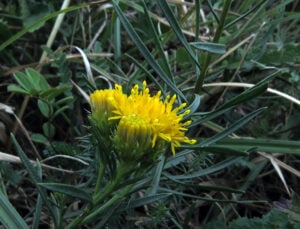
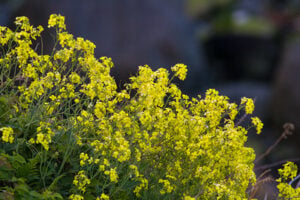
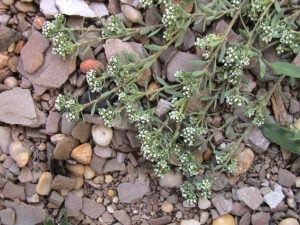
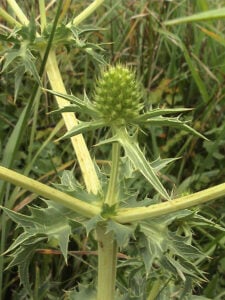


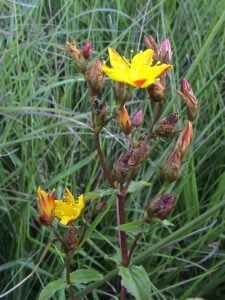
 An aggregate of three species, L. binervosum, L. procerum and L. britannicum, all of which are nationally very rare and endemic to the British Isles: some subspecies are endemic to the Devon coast. They are coastal plants of rocks and head deposits, but are occasionally also found on shingle, pebble beaches and upper saltmarsh. The subspecies, which are found only in Devon, occur on coastal rocks and head deposits along the south coast. Devon populations are probably stable, although very small on some sites. Image by John Walters.
An aggregate of three species, L. binervosum, L. procerum and L. britannicum, all of which are nationally very rare and endemic to the British Isles: some subspecies are endemic to the Devon coast. They are coastal plants of rocks and head deposits, but are occasionally also found on shingle, pebble beaches and upper saltmarsh. The subspecies, which are found only in Devon, occur on coastal rocks and head deposits along the south coast. Devon populations are probably stable, although very small on some sites. Image by John Walters.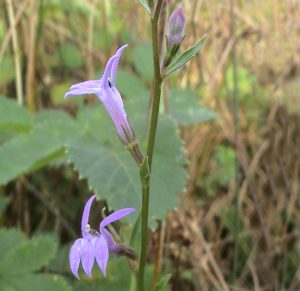
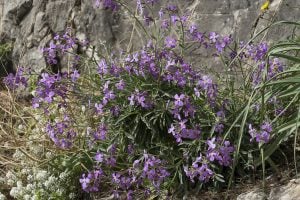
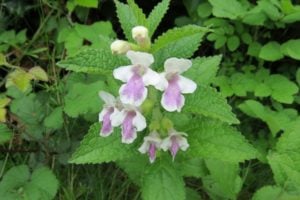
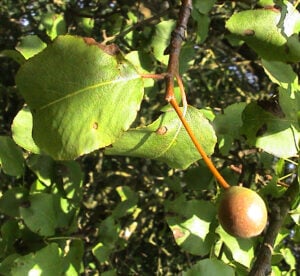
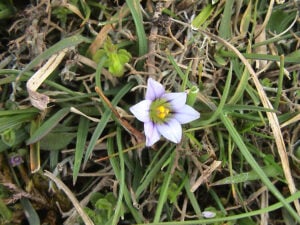 In the British Isles, this tiny crocus is only known from Dawlish Warren in Devon and from a site in Cornwall: it is also found in the Channel Islands. The Dawlish Warren colony is far larger than the Cornish one. At Dawlish Warren, a National Nature Reserve, the plant occurs in dry short sandy turf. The area occupied by the crocus has recently expanded on land managed by Teignbridge District Council and the plant is also doing well on the adjacent golf course which forms part of a Devon Wildlife Trust reserve. Sea level rise, leading to habitat loss through erosion, is a threat.
In the British Isles, this tiny crocus is only known from Dawlish Warren in Devon and from a site in Cornwall: it is also found in the Channel Islands. The Dawlish Warren colony is far larger than the Cornish one. At Dawlish Warren, a National Nature Reserve, the plant occurs in dry short sandy turf. The area occupied by the crocus has recently expanded on land managed by Teignbridge District Council and the plant is also doing well on the adjacent golf course which forms part of a Devon Wildlife Trust reserve. Sea level rise, leading to habitat loss through erosion, is a threat.
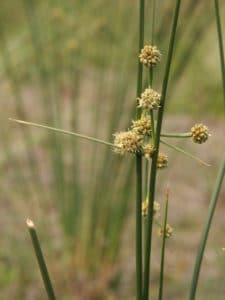
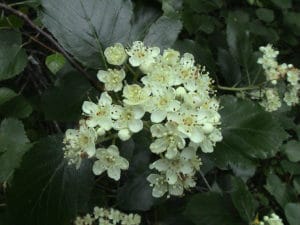

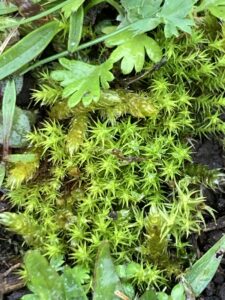
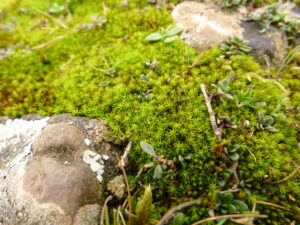



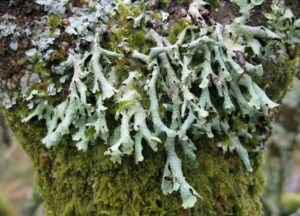
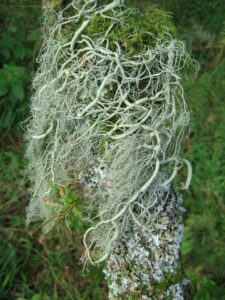
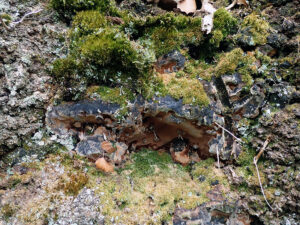 An extremely rare polypore bracket fungus found on the dead parts of ancient and veteran oak trees in historic mediaeval forests and deer parks. Old open-grown oaks seem to be the key habitat: the known European range is France, Ireland and England where it has been reported from just three sites: Woodend Park near Shute (East Devon), Langley Park (Bucks) and Staverton Park (Suffolk). At Woodend Park it occurs on the King John Oak, where in 2008 the species was found for the first time in Britain. The Oak Polypore Fungus Piptoporus quercinus, another Devon Special Species, also lives on ancient oaks in Woodend Park. In recent years bramble and scrub have been cleared away from around the base of the King John Oak, enabling the fungus to be better monitored and hopefully benefiting it.
An extremely rare polypore bracket fungus found on the dead parts of ancient and veteran oak trees in historic mediaeval forests and deer parks. Old open-grown oaks seem to be the key habitat: the known European range is France, Ireland and England where it has been reported from just three sites: Woodend Park near Shute (East Devon), Langley Park (Bucks) and Staverton Park (Suffolk). At Woodend Park it occurs on the King John Oak, where in 2008 the species was found for the first time in Britain. The Oak Polypore Fungus Piptoporus quercinus, another Devon Special Species, also lives on ancient oaks in Woodend Park. In recent years bramble and scrub have been cleared away from around the base of the King John Oak, enabling the fungus to be better monitored and hopefully benefiting it.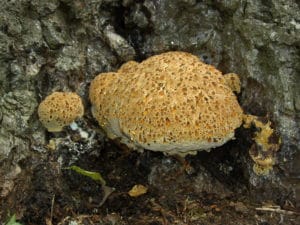
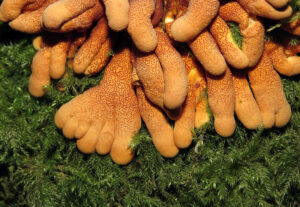
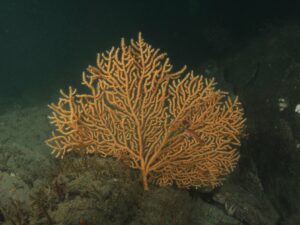
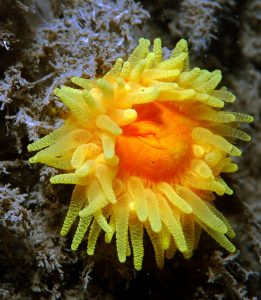
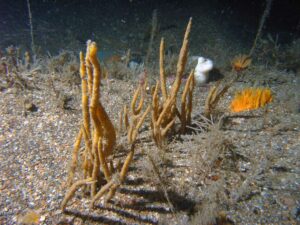
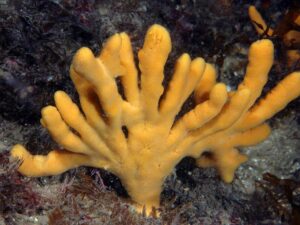
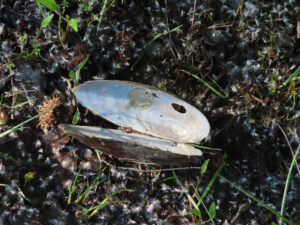 Although this mussel’s stronghold is in Scotland, the conservation of the species across its range is important. It survives in only ten rivers in England. The River Torridge in Devon supports the only sizeable population in southern England. Here about 2,000 individuals live between Hatherleigh and Great Torrington, the last full survey being in 2013 – it is hoped to repeat this in 2020. There is also a very small population (below 100 individuals) on the River Mole. The Devon populations are thought to have the same genetic provenance as those on the Iberian peninsula, unlike those found elsewhere in northern England and Scotland.
Although this mussel’s stronghold is in Scotland, the conservation of the species across its range is important. It survives in only ten rivers in England. The River Torridge in Devon supports the only sizeable population in southern England. Here about 2,000 individuals live between Hatherleigh and Great Torrington, the last full survey being in 2013 – it is hoped to repeat this in 2020. There is also a very small population (below 100 individuals) on the River Mole. The Devon populations are thought to have the same genetic provenance as those on the Iberian peninsula, unlike those found elsewhere in northern England and Scotland.
